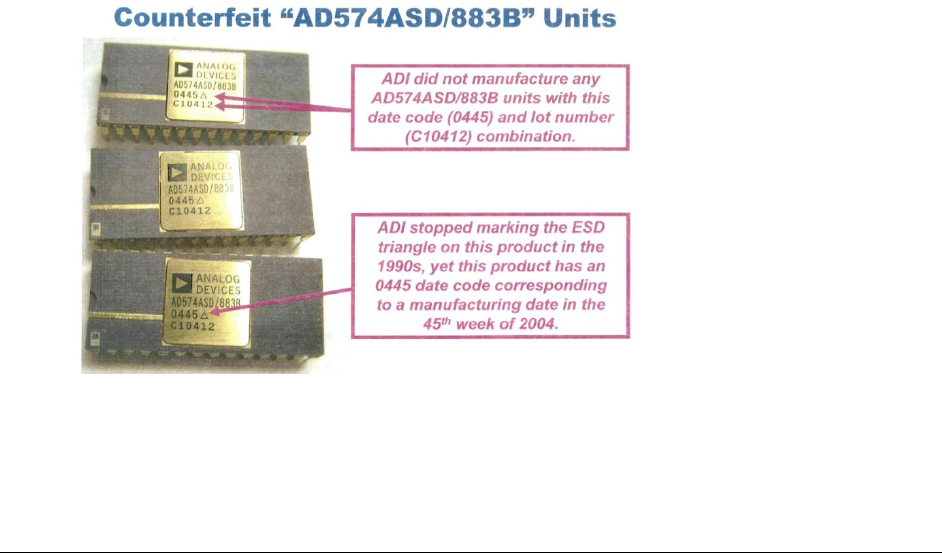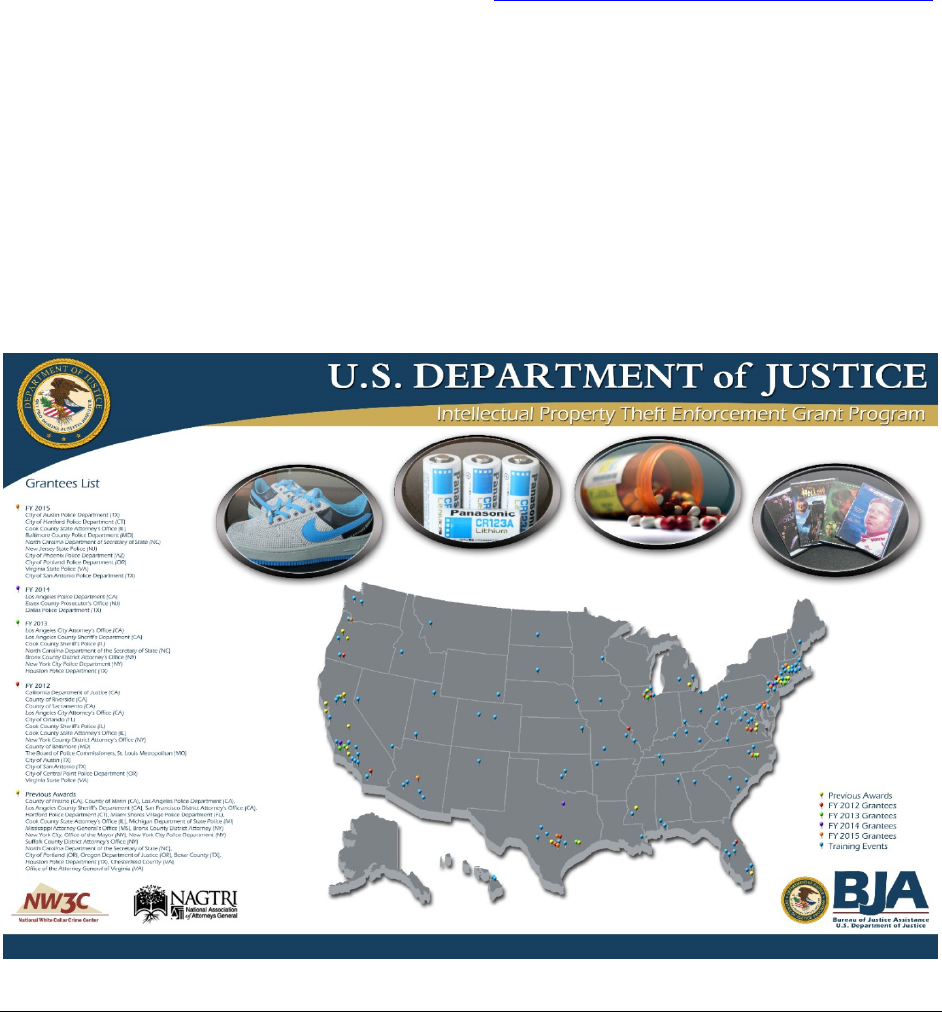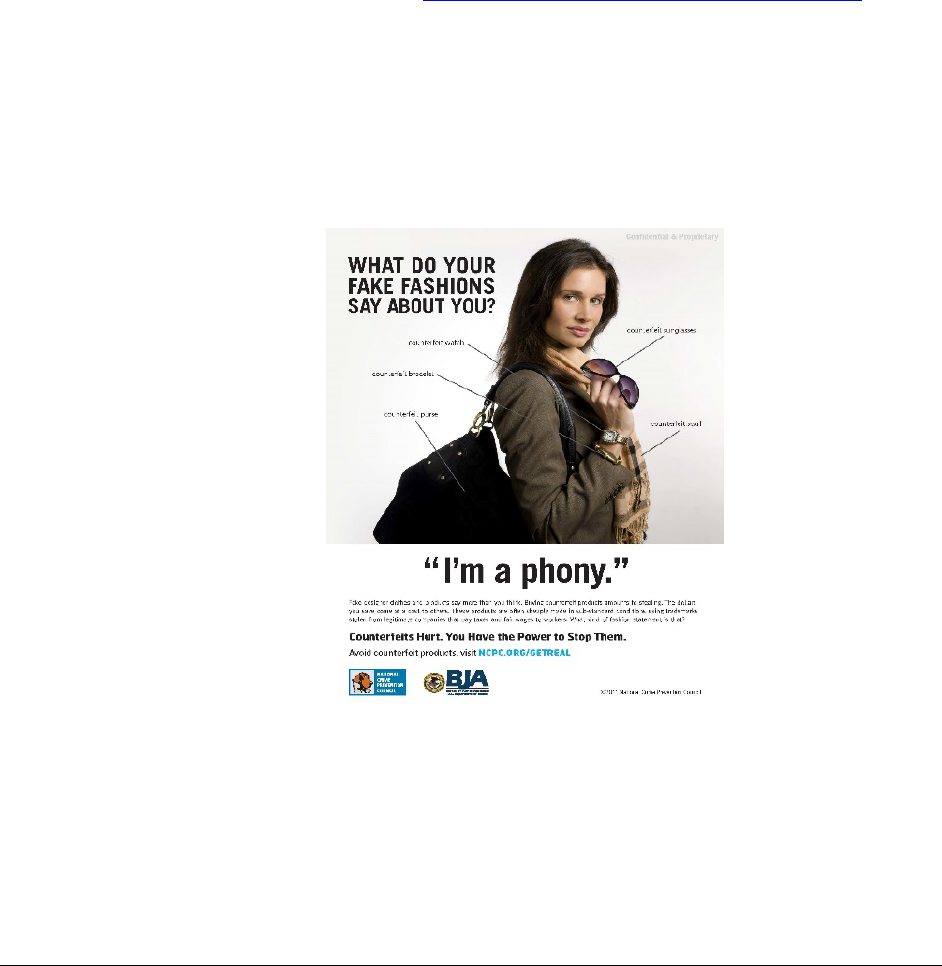
Prosecuting Intellectual
Property Crimes
Introduction . . . . . . . . . . . . . . . . . . . . . . . . . . . . . . . . . . . . . . . . . . . . . . 1
By Sally Q. Yates
Department of Justice Task Force on Intellectual
Property: A Coordinated Response to Combat
Intellectual Property Crime . . . . . . . . . . . . . . . . . . . . . . . . . . . . . . . . . 2
By Miriam H. Vogel
Deciding When to Prosecute an Intellectual Property Case . . . . . . . 7
By Christopher S. Merriam and Kendra R. Ervin
Loss Amount in Trade Secret Cases . . . . . . . . . . . . . . . . . . . . . . . . . 14
By William P. Campos
Prosecuting Copyright Infringement Cases and
Emerging Issues. . . . . . . . . . . . . . . . . . . . . . . . . . . . . . . . . . . . . . . . . . 18
By Jason Gull and Tim Flowers
DOJ’s Strategic Plan for Countering the
Economic Espionage Threat. . . . . . . . . . . . . . . . . . . . . . . . . . . . . . . . 23
By Richard S. Scott and Alan Z. Rozenshtein
IPR Center: Conducting Effective IP Enforcement. . . . . . . . . . . . 27
By Bruce M. Foucart
Operation In Our Sights . . . . . . . . . . . . . . . . . . . . . . . . . . . . . . . . . . . 37
By Justin S. Herring
Prosecuting Counterfeit Prescription Drug Cases. . . . . . . . . . . . . . 40
By Andrew Lay
Chipping Away at a Threat to Our Military and National
Security: The Trafficking of Counterfeit Semiconductors. . . . . . . 46
By Edward Chang
Intellectual Property Enforcement Programs: Helping State and
Local Law Enforcement Combat Intellectual Property Crime . . . 51
By Kristie Brackens
January
2016
Volume 64
Number 1
United States
Department of Justice
Executive Office for
United States Attorneys
Washington, DC
20530
Monty Wilkinson
Director
Contributors’ opinions and statements
should not be considered an
endorsement by EOUSA for any
policy, program, or service.
The United States Attorneys’ Bulletin
is published pursuant to
28 CFR § 0.22(b).
The United States Attorneys’ Bulletin
is published bimonthly by the
Executive Office for United States
Attorneys, Office of Legal Education,
1620 Pendleton Street,
Columbia, South Carolina 29201.
Managing Editor
Jim Donovan
Contractor
Becky Catoe-Aikey
Law Clerk
Mary C. Eldridge
Internet Address
www.usdoj.gov/usao/
reading_room/foiamanuals.
html
Send article submissions
to Managing Editor,
United States Attorneys’ Bulletin,
National Advocacy Center,
Office of Legal Education,
1620 Pendleton Street,
Columbia, SC 29201.
In This Issue

January 2016 United States Attorneys’ Bulletin 1
Introduction
Sally Q. Yates
Deputy Attorney General
U.S. Department of Justice
It is my great pleasure to introduce this edition of the United States Attorneys’ Bulletin devoted to
Intellectual Property (IP). IP crime in the United States and abroad threatens not only our public safety
and economic well-being, but also our national security. Counterfeit products, such as auto parts,
pharmaceuticals, and military equipment can cause death and serious bodily injury. Theft of proprietary
designs, technology, and innovations by competitors can wreak havoc on American industry, creating
unfair market advantages, eroding profits, and causing loss of jobs. Economic espionage by state actors
seeks to harm our national security through attacks on our infrastructure and businesses. Criminals
increasingly use cyber means to carry out these offenses, attempting to become a faceless enemy
committing crimes without attribution. We, as prosecutors, must vigorously defend against these types of
crimes, and continue to utilize all available resources to do so.
As Deputy Attorney General, I serve as the Chair of the Department of Justice Task Force on IP,
composed of senior representatives within the Department. Since its creation in 2010 by then-Attorney
General Eric Holder, the Department’s IP Task Force has confronted this threat with a strong and
coordinated response. Its mission is to support prosecutions in priority areas, provide heightened civil
enforcement, achieve greater coordination among federal, state, and local law enforcement partners, and
increase focus on international enforcement efforts.
Specifically, the Department focuses its efforts to aggressively investigate and prosecute a wide
range of IP crimes, with a particular emphasis on: (1) public health and safety, (2) theft of trade secrets
and economic espionage, and (3) large-scale commercial counterfeiting and piracy. Today our
enforcement efforts at the Department are more vigorous, more strategic, more collaborative, and more
effective than ever before.
This edition of the United States Attorneys’ Bulletin
is the latest resource available to assist
prosecutors in the fight against IP crimes. This issue provides topical guidance and information on IP,
from investigation to sentencing. This
Bulletin contains articles concerning: the IP Task Force and its
function; guidance on prosecuting an IP case; copyright enforcement; the Department’s strategy on
countering economic espionage; the National IP Rights Center led by U.S. Immigration and Customs
Enforcement’s Homeland Security Investigations; the IP enforcement programs of the Office of Justice
Programs; sentencing considerations; and articles providing case examples in the prosecution of
counterfeit prescription drugs, counterfeit semiconductors, and online commercial counterfeiting
operations.
I encourage each of you to work with your fellow prosecutors and law enforcement partners to
participate in the Department’s multi-faceted approach to combatting this type of crime. It is through your
leadership and vigilance as prosecutors that we will continue to effectively stay ahead of the ever-
adapting threat of IP crime.

2 United States Attorneys’ Bulletin January 2016
Department of Justice Task Force on
Intellectual Property: A Coordinated
Response to Combat Intellectual
Property Crime
Miriam H. Vogel
Associate Deputy Attorney General
United States Department of Justice
“[P]rotecting the nation’s intellectual property is a vital part of the Justice Department’s mission.”
Remarks by Attorney General Loretta E. Lynch at MassChallenge Roundtable Discussion, Oct. 2, 2015,
available at
http://www.justice.gov/opa/speech/attorney-general-loretta-e-lynch-announces-new-
intellectual -property-enforcement-program.
I. Introduction
Why does the Department of Justice focus its leadership efforts and precious resources on
intellectual property (IP) crime? The Department is keenly aware that IP crime is anything but victimless
—it is a crime that threatens our nation’s well-being, attacking our economy, public welfare, and national
security.
We are fortunate to benefit from an economy that is thriving from brilliant innovations and
breakthroughs in technology and health. Our innovations are also the envy of the world. Unfortunately, as
our developments become more efficient and important, the motivation and means to enable IP crime
continue to grow accordingly. With the spread of innovation comes the threat of increased harms to an
increased number of people by counterfeit products that can cause serious bodily injury or even death.
The criminals who carry out IP offenses increasingly use cyber means to steal more swiftly, effectively,
and with less traceability. We, therefore, have had to become faster, smarter, and better coordinated to
track them down.
The Department has responded to these threats with a strong and coordinated approach. Through
the leadership and coordination of the Attorney General’s IP Task Force, created 2010, the Department
has remained coordinated in confronting the growing number of domestic and international IP crimes.
Through its members, the Task Force works to identify and implement a multi-faceted strategy with our
federal, state, and international partners to effectively combat this type of crime.
We appreciate this opportunity to ensure that the investigators and prosecutors who fight IP crime
on the front lines are acquainted with the tools that are available through the Task Force writ large or
through specific Task Force members.
II. Mission, priorities, and composition
The mission of the Department’s IP Task Force is to support prosecutions in priority areas,
provide heightened civil enforcement, achieve greater coordination among federal, state, and local law
enforcement partners, and increase focus on international enforcement efforts.

January 2016 United States Attorneys’ Bulletin 3
Specifically, the IP Task Force supports the Department’s efforts to aggressively investigate and
prosecute a wide range of IP crimes, with a particular focus on: (1) public health and safety, (2) theft of
trade secrets and economic espionage, and (3) large-scale commercial counterfeiting and piracy. The
Department places a special emphasis on the investigation and prosecution of IP crimes that are
committed or facilitated by cyber-enabled means or perpetrated by organized criminal networks. The IP
Task Force also supports state and local law enforcement’s efforts to address criminal intellectual
property enforcement by providing grants and training.
IP Task Force members include the Assistant Attorney Generals (or equivalent) for the following
components:
• Antitrust Division
• Civil Division
• Criminal Division
• Federal Bureau of Investigation
• National Security Division
• Office of Justice Programs
• Office of Legislative Affairs
• Office of Public Affairs
• United States Attorneys’ offices/Executive Office for United States Attorneys
The IP Task Force also works closely with the Office of the Intellectual Property Enforcement
Coordinator, housed in the White House Office of Management and Budget.
III. Members of the IP Task Force
The Department investigates and prosecutes a wide range of IP crimes. Primary investigative and
prosecutorial responsibility within the Department rests with the FBI, the United States Attorneys’
offices, the Criminal Division’s Computer Crime and Intellectual Property Section (CCIPS), the National
Security Division (NSD), and, with regard to offenses arising under the Food, Drug, and Cosmetic Act,
the Consumer Protection Branch of the Civil Division. Each Task Force member plays an essential role in
the coordinated effort to investigate, prosecute, and prevent IP crimes, as discussed in each brief summary
below.
A. Antitrust Division
The mission of the Antitrust Division is to promote economic competition through enforcing and
providing guidance on antitrust laws and principles. Consumers, and the economy as a whole, benefit
from the competition and innovation that result from consistent application of sound antitrust principles to
intellectual property rights. The Division accomplishes its mission by enforcing the Federal antitrust laws
against illegal, collusive, or exclusionary conduct, while supporting the incentives to innovate created by
intellectual property rights; promoting the procompetitive use of intellectual property rights through
guidelines, appellate briefs, policy statements, reports, hearings, workshops, and speeches; and actively
engaging with our foreign counterparts and multilateral organizations to promote application of
competition laws to intellectual property rights that is based on analysis of competitive effects, not
domestic or industrial policy goals.

4 United States Attorneys’ Bulletin January 2016
More information about the Antitrust Division is available at http://www.justice.gov/atr.
B. Civil Division
The Civil Division serves a critical role in protecting and enforcing intellectual property rights
and in protecting the public interest in the proper functioning of the intellectual property laws. In the
intellectual property field, as elsewhere, the Division’s principal function is to represent the United States,
federal agencies, and federal officials in civil litigation, both as a party and amicus curiae. In conjunction
with the Office of the Solicitor General, Civil Division plays a leading role in formulating and presenting
the views of the United States on intellectual property matters in response to invitations from the Supreme
Court, the Federal Circuit, and other courts. In addition, Civil Division attorneys participate in outreach
and training programs to promote the protection of intellectual property rights and combat trade in
counterfeit goods. The components of the Civil Division principally involved in intellectual property
matters are the Consumer Protection Branch, the Intellectual Property Section of the Commercial
Litigation Branch, and the Appellate Staff.
The Consumer Protection Branch leads the Justice Department’s efforts to enforce consumer
protection statutes throughout the United States. Its cases are rooted in our nation’s fundamental
consumer protection laws, establishing crucial precedents and protecting American consumers from
threats to their health, safety, and wallet. The Consumer Protection Branch works closely with agencies
such as the Food and Drug Administration, the Federal Trade Commission, the Consumer Product Safety
Commission, the National Highway Traffic Safety Administration, and the Consumer Financial
Protection Bureau.
The Intellectual Property Section of the Commercial Litigation Branch represents the United
States in matters where a patent, copyright, trademark, or trade secret is at issue. Many of the cases the
Section handles involve complex technologies, such as pharmaceutical compositions and highly
sophisticated electronic devices. In order to meet the challenges presented by these cases, all attorneys
assigned to the Section have a degree in one of the physical sciences or in an engineering field, and are
eligible for admission to practice before the United States Patent and Trademark Office in patent matters.
The Appellate Staff represents the United States, its agencies, and officers in civil cases in the
federal courts of appeals. The Appellate Staff handles appeals involving all of the subject-matter areas
litigated by the Civil Division, including intellectual property matters, and practices in all 13 of the
federal courts of appeals, as well as in the United States Supreme Court. The Appellate Staff's portfolio
includes many of the most difficult and controversial civil cases in which the Federal Government is
involved.
More information about the Civil Division is available at http://www.justice.gov/civil
; the IP
Section of the Commercial Litigation Branch at http://www.justice.gov/civil/intellectual-property-section;
the Consumer Protection Branch at http://www.justice.gov/civil/consumer-protection-branch; and the
Appellate Staff at http://www.justice.gov/civil/appellate-staff.
C. Criminal Division
The Criminal Division’s Computer Crime and Intellectual Property Section (CCIPS) pursues
three overarching goals: to deter and disrupt computer and IP crime, to guide the proper collection of
electronic evidence by investigators and prosecutors, and to provide technical and legal advice and
assistance on these issues to agents and prosecutors in the United States and around the world. CCIPS
accomplishes its mission by pursuing and coordinating investigations and prosecutions, and helping
others to do so; by engaging in activities that build the international legal and operational environment
that allows for successful investigations and prosecutions; by providing expert legal and technical advice
and support to the Department, investigative agencies, and other executive branch agencies; and by

January 2016 United States Attorneys’ Bulletin 5
developing and advocating for policies and legislation relating to computer crime, IP crime, and
collection of electronic evidence. CCIPS’s work often entails close coordination on national security,
intelligence, and international issues.
More information about CCIPS is available at www.cybercrime.gov
.
D. Federal Bureau of Investigation
Preventing intellectual property theft is a priority of the FBI’s criminal investigative program.
The FBI specifically focuses on the theft of IP products that can impact consumers’ health and safety,
such as counterfeit aircraft, car, and electronic parts. Their recent investigative successes are due to
linking the considerable resources and efforts of the private sector with law enforcement partners on local,
state, federal, and international levels.
Given the level of IP protection priority and an interest in maximizing the use of resources, the
FBI has recently announced a new collaborative strategy. This new strategy builds upon the work
previously done by the Department, while also working with industry partners to make enforcement
efforts more effective. As part of this strategy, the FBI will partner with third-party marketplaces to
ensure they have the right analytical tools and techniques to combat intellectual property concerns on
their Web sites. The FBI also will serve as a bridge between brand owners and third-party marketplaces in
an effort to mitigate instances of the manufacture, distribution, advertising, and sale of counterfeit
products. This new strategy will help law enforcement and companies better identify, prioritize, and
disrupt the manufacturing, distribution, advertising, and sale of counterfeit products. High level, more
complex crimes can then be investigated by the FBI and other partner law enforcement agencies of the
National Intellectual Property Rights Coordination Center. See Department of Justice Press Release,
Justice Department Announces New Strategy to Combat Intellectual Property Crimes and $3.2 Million in
Grant Funding to State and Local Law Enforcement Agencies (Oct. 2, 2015), available at
http://www.
justice.gov/opa/speech/attorney-general-loretta-e-lynch-announces-new-intellectual-property-
enforcement-program.
More information about the FBI’s investigation of intellectual property rights is available
at https://www.fbi.gov/about-us/investigate/white_collar/ipr/ipr
. For more information regarding the
National Intellectual Property Rights Coordination Center, please see the article in this issue entitled “IPR
Center: Conducting Effective IP Enforcement.”
E. National Security Division
The NSD’s mission is to carry out the Department's highest priority: to combat terrorism and
other threats to national security. With respect to intellectual property, NSD’s Counterintelligence and
Export Control Section works with the FBI, DHS, and U.S. Attorney’s offices across the country to
investigate, prosecute, and otherwise disrupt economic espionage and export control offenses.
Additionally, the Office of Intelligence provides legal support to the FBI and other members of the
Intelligence Community in conducting surveillance under the Foreign Intelligence Surveillance Act, and,
in particular, investigations involving the theft of intellectual property with national security dimensions.
As a reflection of NSD’s prioritization of national security threats involving malicious cyber activity, in
2012 NSD and CCIPS jointly stood up the National Security Cyber Specialists Network, composed of
prosecutors in every U.S. Attorney’s office and attorneys at Main Justice. This is a resource for training
and coordination on computer hacking offenses with national security implications, many of which
involve the theft of trade secrets and sensitive military technology.
More information about the National Security Division is available at
http://www.justice.
gov/nsd, as well as the article entitled “DOJ’s Strategic Plan for Countering the Economic Espionage
Threat” included in this issue.

6 United States Attorneys’ Bulletin January 2016
F. United States Attorneys’ offices
The United States Attorneys serve as the nation’s principal litigators under the direction of the
Attorney General. Through the Cyber and Intellectual Property subcommittee of the Attorney General’s
Advisory Committee, designated U.S. Attorneys advise the Attorney General about policies and issues
relating to intellectual property enforcement. The subcommittee is led by its chairperson, U.S. Attorney
David Hickton of the Western District of Pennsylvania, and its vice-chair, U.S. Attorney Rod Rosenstein
of the District of Maryland.
In each United States Attorney’s office, one or more Assistant United States Attorneys (AUSAs)
has received specialized training in the enforcement of intellectual property laws through the Computer
Hacking and Intellectual Property (CHIP) program. CHIP attorneys have four major areas of
responsibility including: (1) prosecuting computer crime and IP offenses, (2) serving as the district’s
legal counsel on matters relating to those offenses and the collection of electronic evidence, (3) training
prosecutors and law enforcement personnel in the region, and (4) conducting public and industry outreach
and awareness activities. These CHIP attorneys and other AUSAs work closely with special agents from
the FBI, Immigration and Customs Enforcement, and other federal law enforcement agencies to
investigate and prosecute violations of federal copyright, trademark, and trade secrets laws.
More information about United States Attorney’s offices is available at
http://www.justice
.gov/usao. Please visit http://www.justice.gov/usam/usam-9-50000-chip-guidance for more information
about the CHIP program.
G. Office of Justice Programs
Housed in the Department's Office of Justice Programs, the Bureau of Justice Assistance (BJA)
provides leadership and assistance to state and local partners, including the Intellectual Property Theft
Enforcement Program (IPEP), in coordination with the Department of Justice’s Computer Crime and
Intellectual Property Section and Task Force on Intellectual Property. The IPEP was initiated at the
direction of the Attorney General in FY 2009, and consists of three major components: law enforcement
efforts at the state and local level, a national training and technical assistance program, and a public
education campaign. Since that time, BJA has awarded over $19 million in funding to support our
partners in their fight against IP crime, including grants and training and technical assistance, over $14
million of which was in awards to local law enforcement agencies.
More information about the Office of Justice Programs is available at http://ojp.gov/
, as well as
the article entitled “Intellectual Property Enforcement Programs: Helping State and Local Law
Enforcement Combat Intellectual Property Crime” included in this issue.
IV. Conclusion
Drawing on the strengths of each of its members and each of its partners in both government and
private industry, the Department’s enforcement efforts against IP crime are more strategic, collaborative,
and impactful than ever before. The Task Force will continue to support the Department’s coordinated
approach to effectively combatting IP crime in the United States and abroad— working to identify and
evolve the Department’s response as criminals continue to advance their schemes.
For more information about the IP Task Force, updates on IP enforcement, and additional
resources, please visit http://www.justice.gov/iptf
.❖

January 2016 United States Attorneys’ Bulletin 7
ABOUT THE AUTHOR
Deciding When to Prosecute an
Intellectual Property Case
Christopher S. Merriam
Deputy Chief for Intellectual Property
Computer Crime and Intellectual Property Section
U.S. Department of Justice
Kendra R. Ervin
Assistant Deputy Chief for Intellectual Property
Computer Crime and Intellectual Property Section
U.S. Department of Justice
I. Introduction
Federal prosecutors know that deciding whether to prosecute a particular case requires the
exercise of judgment and discretion, which can take years of experience and many cases to develop.
Although intellectual property (IP) crimes are not charged as regularly as many other types of federal
offenses, the prosecution of IP cases can have a significant effect in protecting the public and limiting
economic harm to victims, while at the same time creating a substantial deterrent to similar conduct by
others. How should you decide whether a particular case of trafficking in counterfeit computer chips,
copying and distribution of pirated music or software over the Internet, or the theft of trade secrets should
be charged, even where a victim or investigator provides evidence to prove all the elements? What special
considerations may come into play in a given case? Federal prosecutors may need to recalibrate the usual
standards for case consideration when evaluating the merits of an IP case based on a few characteristics of
such cases, including:
• IP crime always has a direct victim (the holder of the IP rights infringed), but it also undermines
the IP system as a whole, may involve fraud perpetrated on the recipient of the counterfeit good
or pirated work, and will often involve related offenses ranging from smuggling and money
laundering to computer intrusions and the distribution of malware.
• Although the majority of IP infringement may be addressed through civil action by the rights
holder, there are many instances where civil remedies are not effective because of the difficulty in
identifying a party through civil process, infringers doing business overseas, or in cases where
repeat infringers ignore or avoid civil judgments.
• Effective enforcement of IP laws is essential to the foundation of the modern economy in both
protecting consumers and encouraging innovation.
❏
Miriam H. Vogel is Associate Deputy Attorney General. In addition to serving as the staff lead on the
Department’s Intellectual Property Task Force, she works with several components on behalf of the
Deputy Attorney General, including Antitrust and the Community Relations Service. Prior to coming to
the Department of Justice, she served as an in-house attorney and in private practice, with a focus on
intellectual property law.
✠

8 United States Attorneys’ Bulletin January 2016
• The protection of IP rights in cases involving the public health and safety, large scale commercial
piracy and counterfeiting, and the theft of trade secrets are DOJ priority prosecution areas
identified by the Deputy Attorney General through the IP Task Force.
The Computer Crime and Intellectual Property Section’s Prosecuting Intellectual Property
Crimes manual serves as a valuable resource for evaluating these, as well as the other issues, that arise in
IP cases. See Department of Justice, Computer Crime and Intellectual Property Section, Prosecuting
Intellectual Property Crimes (2013). In general, with respect to IP crimes, federal prosecutors should take
into account the same considerations as they would with any federal crime. See, e.g., U.S. Attorneys’
Manual § 9-27.220. While individual U.S. Attorney’s offices may evaluate these factors using different
standards, the discussion below attempts to tailor these factors to issues likely to surface in criminal IP
matters.
II. The federal interest in prosecution of IP crimes
In determining the scope of the federal interest that would be served by a prosecution of a
particular IP case, the attorney for the government needs to weigh several relevant considerations,
including:
(1) [current] Federal law enforcement priorities; (2) The nature and seriousness of the
offense; (3) The deterrent effect of prosecution; (4) The person’s culpability in
connection with the offense; (5) The person’s history with respect to criminal activity; (6)
The person’s willingness to cooperate in the investigation or prosecution of others; and
(7) The probable sentence or other consequences if the person is convicted.
Id. § 9-27.230. This article discusses each of these factors below with detailed attention to IP crimes. The
last factor—the probable sentence—warrants particular attention in light of several amendments over the
past decade to sentencing guideline § 2B5.3 to more accurately reflect the loss caused by IP crime.
A. The federal focus on IP crime
Recognition of the importance of IP to the national economy, and the growing scale of IP theft,
led the Department of Justice to designate IP crime as a “priority” for federal law enforcement as early as
1999. In 2010, Attorney General Holder instituted the current version of the Department’s Intellectual
Property Task Force to emphasize the importance of intellectual property in a wide range of DOJ
responsibilities. The work and priorities of the IP Task Force are spelled out in greater detail in a separate
article in this issue, but it is worth emphasizing the particular focus on the identified prosecution
priorities: (1) Health and Safety of the American Public, (2) Theft of Trade Secrets and Economic
Espionage, and (3) Large-Scale Commercial Counterfeiting and Piracy Operations. To support
investigations and prosecutions in this area, the Department has more than 260 Computer Hacking and
Intellectual Property (CHIP) attorneys across the country who receive special training to address both IP
and cyber-crimes, and 16 attorneys in the Criminal Division’s Computer Crime and Intellectual Property
Section specializing entirely on IP crime. Both the FBI and ICE/HSI have agents specifically assigned to
handle IP cases, and a total of 23 domestic and international law enforcement agencies coordinate on IP
cases through the National Intellectual Property Rights Coordination Center, while the Department’s
Bureau of Justice Assistance provides grants and training to support IP investigations and prosecutions by
state and local authorities.
B. The nature and seriousness of the offense
Just as with other criminal offenses, the nature and seriousness of IP crimes varies, and the
consideration of the specific facts and circumstances surrounding each case is critical. Limited federal
resources should not be diverted to prosecute inconsequential cases or cases in which the violation is only

January 2016 United States Attorneys’ Bulletin 9
technical. U.S. Attorneys’ Manual § 9-27.230. Prosecutors may consider any number of factors to
determine the seriousness of an IP crime, including:
1. Whether the counterfeit goods or services endanger the public’s health or safety (e.g.,
counterfeit drugs or automotive parts)
2. The nature of the trade secret information (e.g. critical technologies with military or other
sensitive applications)
3. The scope of the infringing or counterfeiting activities (e.g., whether the subject infringes
or traffics in multiple items or infringes upon multiple industries or victims), as well as
the volume of infringing items manufactured or distributed
4. The scale of the infringing or counterfeiting activities (e.g., the amount of illegitimate
revenue and any identifiable illegitimate profit arising from the infringing or
counterfeiting activities)
5. The number of participants and the involvement of any organized criminal group
6. The scale of the victim’s loss or potential loss, including the value of the infringed item
or trade secret information, the impact of the infringement or trade secret theft on the
market for the infringed item, and the damage to the rights holder’s or trade secret
owner’s business
7. Whether the victim or victims took reasonable measures (if any) to protect against the
crime
8. Whether the purchasers of the infringing items were victims of a fraudulent scheme, or
whether there is a reasonable likelihood of consumer mistake as a result of the subject’s
actions
C. The deterrent effect of prosecution
Deterrence of criminal conduct is one of the primary goals of the criminal justice system.
Experience demonstrates that many infringers will not be deterred by civil liability, which they can treat
as a cost of doing business. For example, even when the rights holder has obtained a permanent injunction
or consent decree, that civil remedy may not necessarily deter some defendants. A defendant may respond
to such civil remedies by altering the item upon which they are infringing, such as counterfeiting
automotive parts bearing marks of one automotive manufacturer after being the subject of an injunction
obtained by another automotive manufacturer. Another defendant may shut down his operations only to
quickly reopen under a different corporate identity.
Criminal prosecution may more effectively deter a violator from repeating his or her crime.
Criminal prosecution of IP crimes is also important for general deterrence. Many individuals may commit
intellectual property crimes not only because they can be relatively easy to commit with technological
advances and more sophisticated methods of manufacturing and distribution, but also because the subjects
believe they will not be prosecuted. Criminal prosecution plays an important role in shaping public
perceptions of right and wrong. The resulting public awareness of effective prosecutions can have a
substantial deterrence effect. Even relatively small scale violations, if permitted to take place openly and
frequently, can lead members of the public to believe that such illicit conduct is tolerated in American
society. While some cases of counterfeiting or piracy may not result in provable direct loss to the rights
holder, the widespread commission of IP crimes with impunity can be devastating to the value of such
rights.

10 United States Attorneys’ Bulletin January 2016
D. The individual’s culpability in connection with the offense
Multiple individuals working in concert, such as a company that traffics in counterfeit goods or
pirated software, often commit IP crimes. See Prosecuting Intellectual Property Crimes § XI.E (2013)
(discussing special considerations for cases involving corporations). The individuals in such an
organization are not necessarily equally culpable. For example, a prosecutor may reasonably conclude
that some course other than prosecution would be appropriate for a relatively minor participant. In
considering the relative culpability of specific individuals within a larger organization, a number of non-
exclusive factors have proven helpful, including: (1) whether the person had oversight responsibility for
others, (2) whether the person specifically directed others to commit the offense, (3) whether the person
profited from the offense, (4) whether the person was specifically aware of the wrongful nature of the
activity, as evidenced by the receipt of a warning such as a “cease and desist” letter from the rights holder
or a seizure notice letter from Customs and Border Protection (CBP), or by a statement to collaborators
admitting wrongfulness, but nonetheless continued to engage in the activity, and (5) whether the person
took affirmative steps, such as creating misleading records or destroying evidence, to deter investigation,
and thereby facilitate commission of the offense.
E. The individual’s history with respect to criminal activity
The subject’s history with respect to criminal activity will, of course, be extremely fact
dependent. Defendants may have a history of engaging in a pattern of fraudulent conduct not necessarily
limited to IP crimes. It should not be assumed that commission of an IP crime is an exception to an
otherwise law-abiding life. The repeat-offender provisions in the intellectual property crime statutes, e.g.
18 U.S.C. § 2320(b)(1)(B), and the United States Sentencing Guidelines, try to ensure that repeat
offenders receive stiffer sentences.
In addition to the defendant’s criminal history, it is appropriate to consider his or her history of
civil IP violations. Sources for determining the defendant’s history of civil IP offenses include civil
litigation records, the victim’s legal department and private investigators, and any state consumer
protection agencies to which consumers might have complained.
F. The individual’s willingness to cooperate in the investigation or prosecution of others
A defendant’s willingness to cooperate will depend on the individual. Nevertheless, it is
important to recognize that in IP cases, defendants often have a substantial capacity for cooperation, if
they are, in fact, willing. Since IP crimes often require special materials, equipment, or information, and
can involve multiple participants across the supply chain, defendants often can provide substantial
assistance. A defendant might provide valuable information concerning a domestic or foreign source of
counterfeit goods or pirated works. For instance, if a defendant is investigated for selling counterfeit
health care products on a retail basis, he could provide information as to the wholesaler of those
counterfeit products. The wholesaler, in turn, could provide information regarding the manufacturer, or
about other retailers.
G. The probable sentence or other consequences upon conviction
The consequences that may be imposed if an IP prosecution is successful include imprisonment,
restitution, and forfeiture. In Prosecuting Intellectual Property Crimes, the sentencing provisions are
discussed at § VIII.B-C, whereas restitution (which is generally mandatory in IP cases) is discussed at
§ VIII.D, and forfeiture (which is generally available in IP cases) is discussed at § VIII.E. The probable
sentence is worthy of attention in light of revisions over the past decade to sentencing guidelines § 2B1.1
for Economic Espionage Act (EEA) cases and § 2B5.3 for all other IP offenses.

January 2016 United States Attorneys’ Bulletin 11
Completed EEA cases are sentenced under § 2B1.1, with a base offense level of 6. The value of
the stolen trade secret information largely drives the defendant’s sentence as the offense level increases
according to the amount of loss under § 2B1.1(b)(1). Section 2B1.1, Application Notes, outlines a number
of general methods for calculating loss, and the Prosecuting Intellectual Property Crimes Manual
§ VIII.C.2 provides further explanation regarding factors to consider for loss calculations in trade secret
cases, as well as case law describing potential ways to value trade secrets.
Additionally, as of November 1, 2013, the offense level is increased two points if the defendant
knew or intended that the trade secret would be transported or transmitted out of the United States, see
U.S.S.G. § 2B1.1(b)(12)(A) (2015), and four points if the defendant knew or intended that the offense
would benefit a foreign government, foreign instrumentality, or foreign agent, with a minimum offense
level of 14. See id. § 2B1.1(b)(12)(B). Other enhancements that often arise in EEA cases include the two-
level “sophisticated means” enhancement under § 2B1.1(b)(10(C) and the two-level adjustment for abuse
of a position of trust or use of a special skill under § 3B1.3.
For all other IP offenses, § 2B5.3 governs the sentencing calculations. Since 2000, there have
been five rounds of amendments to this guideline. Several of these amendments are highlighted below,
and the Prosecuting Intellectual Property Crimes Manual § VIII.C.1 discusses each in more detail, and
provides an overview of the guideline calculations for IP offenses governed by § 2B5.3, including
commonly sought enhancement and departure considerations.
• In 2000, the base offense level was increased from 6 to 8, and, in addition to the infringement
amount, the number and type of special offense characteristics were increased to include
characteristics for manufacturing, uploading, or importing infringing items; for infringement not
committed for commercial advantage or private financial gain; and for risk of serious bodily
injury or possession of a dangerous weapon in connection with the offense. See U.S.S.G. App. C
(Amendments 590, 593).
• In 2005 on a temporary basis, and in 2006 as permanent, a new specific offense characteristic
addressing infringement of pre-release works was added. See U.S.S.G. App. C (Amendments
675, 687).
• In 2006 on a temporary basis, and in 2007 as permanent, § 2B5.3 was amended to specify that in
cases under 18 U.S.C. § 2318 or § 2320 involving counterfeit labels, the infringement amount is
based on the retail value of the infringed items to which the labels would have been affixed. See
U.S.S.G. App. C (Amendments 682, 704).
• Most recently, as of the November 1, 2013, if the offense involved a counterfeit drug or
counterfeit military goods and services under certain conditions, the offense level is increased by
2. See U.S.S.G. App. C (Amendment 773). The amendment also specified a minimum offense
level of 14 for offenses involving counterfeit military goods and services. See id.
III. Whether the person is subject to prosecution in another jurisdiction
The U.S. Attorneys’ Manual § 9-27.220 also notes that a prosecutor may properly decline to take
action despite having sufficient admissible evidence when the person is subject to effective prosecution in
another jurisdiction. In IP cases, as in other cases, “[a]lthough there may be instances in which a Federal
prosecutor may wish to consider deferring to prosecution in another Federal district, in most instances the
choice will probably be between Federal prosecution and prosecution by state or local authorities.” U.S.
Attorneys’ Manual § 9-27.240 (cmt). To make this determination, prosecutors should weigh all relevant
considerations, including: (1) the strength of the other jurisdiction’s interest in prosecution, (2) [t]he
other jurisdiction’s ability and willingness to prosecute effectively, and (3) [t]he probable sentence or
other consequences if the person is convicted in the other jurisdiction. Id. § 9-27.240.

12 United States Attorneys’ Bulletin January 2016
Unlike in many other types of criminal offenses, a prosecutor in an IP case arguably may not be
able to defer to a prosecution in the location of the primary victim. For example, a multinational
corporation headquartered in one state may be the victim of trade secret theft without any nexus between
the misappropriation and the district in which the victim company is based. Because of the defendant’s
constitutional and statutory right to be tried in the state and district in which the crime was “committed,”
U.S. Const. art. III § 2 cl. 3; U.S. Const. amend. 6; 18 U.S.C. § 3237, a prosecutor based in the home state
of the victim arguably may not have proper venue over the defendant unless he or she can show that the
“locus delecti” of the counterfeiting took place in that district. This determination must be made “from the
nature of the crime alleged and the location of the act or acts constituting it.” United States v. Rodriguez-
Moreno, 526 U.S. 275, 280 (1999).
Thus, in IP cases, a federal prosecutor often will be called upon to vindicate the rights of
a victim IP holder based in another district, another state, or even another country, because the
defendant may not be subject to prosecution in the victim’s district, state, or nation. Federal
prosecutors should also recognize that local or state authorities may not have a great interest in
punishing violations of the rights of out-of-state victim IP holders. By contrast, ensuring uniform
and reliable national enforcement of the IP laws is an important goal of federal law enforcement.
This goal takes on added significance for federal prosecutors when the victim is based in
a foreign country because of the importance of IP in modern international trade. With consistent
enforcement of IP rights, the United States will continue to set an example of vigorous IP rights
enforcement and to be perceived as hospitable to foreign firms that would register their IP and
engage in business here.
Local and state authorities may also believe that since many IP rights are conferred by the
federal government, they do not have the ability to prosecute any IP crimes. Federal IP laws,
however, generally do not preempt state and local IP laws. There is a provision for federal
preemption for copyright infringement, 17 U.S.C. § 301, although this preemption permits
prosecution for other kinds of crime, and some states have passed laws that indirectly criminalize
conduct involving certain pirated works. Moreover, even if the local or state authorities express a
strong interest in prosecution, they may not have the ability or willingness to prosecute the case
effectively due to competing priorities and limited resources. Consequently, a prosecutor should
evaluate for each individual case whether state or local law enforcement exists as a viable
alternative to federal prosecution.
IV. The adequacy of a noncriminal alternative in an IP case
Prosecutors may consider the adequacy of noncriminal alternatives when addressing an IP case.
Some civil remedies, including ex parte seizure of a defendant’s infringing products and punitive
damages, may be available for certain violations of copyright and trademark rights. 15 U.S.C. § 1116(d)
(2015) (trademark remedies); 17 U.S.C. §§ 502-505 (2015) (copyright remedies). Also, for importers of
trademark-infringing merchandise, CBP may assess civil penalties not greater than the value that the
merchandise would have were it genuine, according to the manufacturer’s suggested retail price for first
offenders, and not greater than twice that value for repeat offenders. These civil fines may be imposed in
CBP’s discretion, in addition to any other civil or criminal penalty or other remedy authorized by law. 19
U.S.C. § 1526(f) (2015). The availability and adequacy of these remedies should be carefully considered
when evaluating an IP case.
Yet civil remedies may be futile under some circumstances. For example, IP crimes are unusual
because they often are committed without the victim company’s knowledge. The victim usually has no

January 2016 United States Attorneys’ Bulletin 13
direct relationship with the infringer—before, during, or after the commission of the crime. If a victim
remains unaware of a violation by a particular defendant, civil remedies generally will be unavailing.
Furthermore, without criminal sanction, infringers or counterfeiters might treat the rare case of the
victim’s civil enforcement of its rights as a cost of doing business.
Another important factor to consider when contemplating civil remedies is that infringers may be
judgment proof. In most cases, the infringer traffics in counterfeit items worth far less than the authentic
ones, and with the increasing prevalence of online sales of counterfeit and pirated goods, the infringer
only needs limited resources to operate his or her business.
There are a number of other circumstances where existing civil remedies may simply be an
insufficient deterrent. For example, there may be cases where there have been prior unsuccessful efforts
by a victim to enforce IP rights against the defendant or the existence of circumstances preventing such
efforts. Criminal charges may be necessary if counterfeiting, piracy, or theft of trade secrets continues
despite the entry of a permanent injunction or consent decree in a civil case.
V. Conclusion
Because defendants in IP cases can have several victims, including the IP holders or trade secret
owners, society at large, and the recipients of the infringing goods or works, and because reliable
enforcement of federally created IP rights is so important to the growing information economy, federal
prosecutors should carefully consider opportunities to prosecute IP cases. Prosecutors should be aware of
the special characteristics of IP cases when evaluating them against traditional principles and exercising
their prosecutorial discretion. Further guidance is available from the Prosecuting Intellectual Property
Crimes Manual (2013), or from the IP Team at the Computer Crime and Intellectual Property Section
(CCIPS) at (202) 514-1026.❖
ABOUT THE AUTHORS
❏
Christopher S. Merriam is the Deputy Chief for Intellectual Property with the Computer Crime and
Intellectual Property Section of the U.S. Department of Justice. Mr. Merriam leads a group of 15 attorneys
dedicated to intellectual property prosecutions and related issues. During his time at CCIPS, Mr. Merriam
has prosecuted cases of copyright and trade secret theft, and acted as the national contact for trade secret
theft cases arising under the Economic Espionage Act of 1996. He has also worked directly with law
enforcement colleagues in more than 20 nations to help improve criminal enforcement of intellectual
property laws.
Before joining the Justice Department in 2001, Mr. Merriam was a criminal defense lawyer with the firm of
Rochon & Roberts in Washington, DC. Mr. Merriam was an E. Barrett Prettyman Fellow at the Georgetown
University Law Center Criminal Justice Clinic, where he taught criminal law and practice.✠
❏Kendra R. Ervin is the Assistant Deputy Chief for Intellectual Property with the Computer Crime and
Intellectual Property Section of the U.S. Department of Justice. Ms. Ervin assists Deputy Chief Christopher
Merriam in leading a group of 15 attorneys dedicated to IP prosecutions and related issues. In her five years
with CCIPS, Ms. Ervin has prosecuted large-scale, multi-jurisdictional IP crimes, participated in domestic
and international IP enforcement training and outreach, and helped to develop and draft legislative and
policy initiatives addressing all facets of IP crime.
Prior to joining CCIPS, Ms. Ervin was employed as an associate at the law firm of Williams & Connolly,
where she specialized in patent litigation. Ms. Ervin also served as a law clerk on the United States Court of
Appeals for the Federal Circuit.✠

14 United States Attorneys’ Bulletin January 2016
This article updates an earlier article written by David Goldstone for the March 2001 issue of the United
States Attorneys’ Bulletin.
Loss Amount in Trade Secret Cases
William P. Campos
Assistant United States Attorney
Intellectual Property Crimes Coordinator
Eastern District of New York
I. Introduction
Intellectual property plays an important role in the United States economy. President Obama
noted that “[o]ur single greatest asset is the innovation and the ingenuity and creativity of the American
people. It is essential to our prosperity and it will only become more so in this century.” See
http://www.whitehouse.gov/the-press-office/remarks-president-exportimport-banks-annual-conference .
Likewise, President Clinton noted that “[t]rade secrets are an integral part of virtually every sector of our
economy and are essential to maintaining the health and competitiveness of critical industries operating in
the United States. Economic espionage and trade secret theft threaten our Nation’s national security and
economic well-being.” See Presidential Statement on Signing the Economic Espionage Act of 1996, 2
Pub. Papers 1814-15, 1996 WL 584924 (Oct. 11, 1996).
Economic espionage is a significant threat to American businesses, particularly as the United
States moves to a high-technology economy. The theft of sensitive business information is not only
damaging to businesses, but is also difficult to detect when done by company insiders.
Congress responded to the adverse impact that trade secret theft has on the U.S. economy in
enacting the Economic Espionage Act of 1996 (EEA): “The development and production of proprietary
economic information is an integral part of U.S. business and is thus essential to preserving the
competitiveness of the U.S. economy.” S. Hrg. 104-499, at 2, 1996 WL 90824 (Feb. 28, 1996) (opening
statement of Sen. Arlen Specter). “A piece of information can be as valuable to a business as in fact a
factory is. The theft of that information could do more harm than if an arsonist torched that factory.” Id. at
3, 1996 WL 90789 (Feb. 28, 1996) (opening statement of Sen. Herb Kohl).
In considering whether to enact the EEA, Congress found that “[o]nly by adopting a national
scheme to protect U.S. proprietary economic information can we hope to maintain our industrial and
economic edge and thus safeguard our national security.” S. Rep. 104-359, 11-12, 1996 WL 497065 (July
30, 1996); see also H.R. Rep. 104-788, reprinted in 1996 U.S.C.C.A.N. 4021, 4025 (Sept. 16, 1996)
(finding that a “comprehensive federal criminal statute” “will serve as a powerful deterrent to this type of
crime” and would “better facilitate the investigation and prosecution of [trade secret theft]”).
II. The Guidelines
The EEA, codified at Title 18, United States Code sections 1831 to 1839, provides for the
criminal prosecution of trade secret theft and misappropriation. An important factor in determining a
criminal defendant’s appropriate sentencing range under the U.S. Sentencing Guidelines (U.S.S.G. and
the Guidelines) is the calculation of the “loss amount” pursuant to Section 2B1.1 of the Guidelines. This

January 2016 United States Attorneys’ Bulletin 15
article is intended to address the methods that have been, or could be, used in calculating the loss amount
in trade secret cases.
Generally, the applicable loss amount to be applied to the §2B1.1 table is the greater of the actual
or intended loss to the victim. See U.S.S.G. § 2B1.1, app. n.3(A) (2015). Under the Guidelines, actual loss
is measured as “the reasonably foreseeable pecuniary harm that resulted from the offense,” and intended
loss is measured as the “pecuniary harm that was intended to result from the offense and includes
intended pecuniary harm that would have been impossible or unlikely to occur (e.g., as in a government
sting operation, or an insurance fraud in which the claim exceeded the insured value).” Id. cmt. n.3(A)(i-
ii). The Guidelines also provide a non-exhaustive list of factors that can be used to estimate the loss
amount. See Id. cmt. n.3(A)(i-ii); United States v. Ferguson, 584 F. Supp. 2d 447, 451 (D. Conn. 2008)
(describing the §2B1.1 cmt. 3(C) factors as “a non-exhaustive list of factors a court might consider in
estimating the loss.”).
For example, if property is taken, copied, or destroyed, the measure of loss may be the fair market
value of the property, or the court may consider using the cost to the victim of replacing that property if
the fair market value is impracticable to determine or inadequately measures the harm. See U.S.S.G.
§ 2B1.1, cmt. n.3(C)(i) (2015). But, regardless of which method is chosen to calculate loss, the
Government’s calculation need not be absolutely certain or precise. “The court need only make a
reasonable estimate of the loss.” See id. § 2B1.1 cmt. n. 3(C).
Many thefts of trade secrets cases, however, involve no loss of tangible property or even actual
loss, depending on how quickly the offender was apprehended by law enforcement agents. In November
2009, therefore, the Guidelines were amended to include Application Note 3(C)(ii), which sets forth that
“[i]n the case of proprietary information (e.g., trade secrets), the cost of developing that information or the
reduction in the value of that information that resulted from the offense” is to be considered in estimating
the loss amount. The amendment made explicit what several courts had already done, namely, to consider
the research and development costs as an alternative measure of the loss amount in a trade secret case. See
e.g. United States v. Ameri, 412 F.3d 893, 900 (8th Cir. 2005); See also United States v. Four Pillars
Enterprise Company, 253 F. App’x 502, 512 (6th Cir. 2007) (unpublished opinion); United States v.
Wilson, 900 F.2d 1350, 1355-56 (9th Cir. 1990). The legislative history of the EEA also touches on the
significance of the research and development costs associated with trade secrets:
As this Nation moves into the high-technology, information age, the value of these
intangible assets will only continue to grow. . . . This material is a prime target for theft
precisely because it costs so much to develop independently, because it is so valuable.
S. Rep. No. 359, 104th Cong., 2d Sess. (1996).
In trade secret cases, however, there is oftentimes no actual market for the information that was
stolen—it had been kept secret. In those cases, as stated in U.S.S.G 3. § 2B1.1, cmt. n.(C)(ii), the loss
amount may be the cost of developing the stolen information or the reduction in value of that information
that resulted from the offense. Regardless of which method is chosen to calculate loss, the Government’s
calculation need only be a “reasonable estimate of the loss,” as required by § 2B1.1 cmt. n.3(C).
III. Preparing for sentencing
In preparing to determine the appropriate loss amount in a trade secret theft sentencing, there first
must be a determination as to whether a loss amount can be reasonably calculated. Among the factors to
consider is whether the defendant was paid for the item or information stolen. The amount paid may be an
appropriate measure of the market value of the trade secret and, hence, the loss amount. If the defendant
did not actually sell the information before the arrest, then one should determine whether he tried to sell
it. Again, the amount of the proposed sale may be an appropriate measure of the market price, and the loss

16 United States Attorneys’ Bulletin January 2016
amount. In any event, the item or information stolen may have taken years to develop, and one should
also try to determine the research and development costs incurred by the victim. While the research and
development costs may not be the best or sole component of the estimate of Guidelines loss, it may be the
easiest to obtain and explain.
Explaining the Guidelines loss to the court could be challenging. Oftentimes the defendant is
unable to sell the information or otherwise cause his plan to reach fruition. In those cases, the defendant
will argue that the loss amount is zero. The victims of the theft correctly point out that the stolen
information could have caused a catastrophic loss to the company. Given these competing views, which
often amounts to a binary decision matrix (i.e., the loss is zero or 100 percent), it is important to consider
the individual court’s views and to maintain one’s credibility with the court. Consequently, to the extent
possible, one should provide the court with multiple loss calculation methodologies, which likely result in
different loss amounts. If the court has a range of options, it is less likely to assign a value of zero simply
because it rejects one of them.
IV. Examples of loss amount calculations
A good example of providing a court with several loss calculation methodologies is United States
v. Sergey Aleynikov, No. 10 CR 96, 2011 WL 1002237 (S.D.N.Y. Mar. 11, 2011). Aleynikov, a former
computer programmer at Goldman Sachs & Co., was convicted of trade secret theft and Interstate
Transportation of Stolen Property, for stealing Goldman Sachs’s proprietary computer code to benefit his
new employer. The Government first argued that the stolen computer code had a fair market value despite
not being for sale or available to the public, in much the same way a house has a fair market value despite
the owner’s refusal to sell it. Other commercially available computer programs performed tasks similar to
those performed by the stolen programs and could serve as a useful measure of the loss. After all, the theft
provided the defendant with a free version of software he would otherwise have had to pay millions to
purchase from third parties. Next, the Government argued that, assuming a fair market value was
impracticable to determine, the cost to the victim of replacing the code should be used. Finally, the
Government argued that the cost of developing the code, as contemplated in §2B1.1 cmt. 3(C)(ii), should
be used, which would be at least in the range of $7 million to $20 million. This was accepted by the court.
The Government provided thoughtful methodologies to support each of the suggested sentencing options.
It should be noted, however, that this case was later reversed by the Second Circuit on grounds of
statutory construction. See 676 F.3d 71 (2d Cir. 2012).
Likewise, in United States v. Samarth Agrawal,
726 F.3d 235 (2d. Cir. 2013), the Government
provided alternate loss methodologies to the court. Agrawal, a former trader at Societe Generale, was
convicted of trade secret theft and Interstate Transportation of Stolen Property. The jury found that he
stole proprietary computer code used for the firm’s high frequency securities trading business. Agrawal
printed the code onto thousands of sheets of paper, which he then physically removed from the bank's
New York office to his New Jersey home. There, he could use them to replicate Societe Generale's
trading systems for a competitor who promised to pay him hundreds of thousands of dollars.
Testimony at Agrawal’s trial suggested that the company benefiting from the theft expected that
the stolen strategy would help the company realize a profit of between $10 million and $40 million.
Indeed, Societe Generale had generated profits of $10 million per year for three years using the
proprietary code. At sentencing, the defendant argued there was no actual loss and no intended loss. The
Government agreed that there had been no actual loss. Ultimately, however, the Government’s successful
argument for a loss amount of between $7 million and $20 million was based, in part, on the fact that the
cost in developing the stolen programs was approximately $9.9 million. Agrawal was sentenced to 36
months’ incarceration.

January 2016 United States Attorneys’ Bulletin 17
In United States v. Hanjuan Jin, 833 F.Supp.2d 977 (N.D. Ill. 2012), affirmed, 733F.3d 718 (7th
Cir. 2013), the defendant was charged with
economic espionage and theft of trade secrets pursuant to 18
U.S.C. §§1831 and 1832, respectively. The defendant, a software engineer at Motorola, stole the iDen
proprietary telecommunications technology. She planned to leave the United States and work in China. A
November 2011 bench trial resulted in her conviction of theft of trade secrets, but acquittal of economic
espionage. The judge imposed a 48-month prison sentence. Both her conviction and 48-month sentence
were affirmed.
At sentencing, the Government explained that Motorola’s 2011 iDen-related revenues were $365
million. The Government also provided the sentencing judge a loss amount calculation based on the
research and development costs associated with some of the stolen information. Based on the research and
development costs of between $20 million and $50 million, the Guidelines range was 121-151 months.
Ultimately, despite the high Guidelines range, the court sentenced the defendant to 48 months’
incarceration because of her significant health issues.
In United States v. Walter Liew, 11 CR 573 (N.D.CA Dec. 9, 2013) (unpublished opinion), Liew
and his co-conspirators were convicted by a jury of economic espionage, among other crimes. Liew stole
trade secrets from the DuPont Company, consisting of the processes to manufacture titanium dioxide
(TiO2), and sold them to a Chinese company. Liew obtained $28 million from the Chinese company.
At sentencing, the Government noted the difficulty in accurately determining loss where the
stolen information represented “decades of research and design at DuPont.” Govt. Sentencing Memo at 6.
Indeed, one DuPont employee who testified at trial stated that, during his tenure at the company,
approximately $150 million was spent annually to improve the TiO2 facilities. See Id. at 7. The
Government rested on the certainty of the $28 million that Liew obtained.
The court sentenced Liew on the Trade secret counts to 120 months’ imprisonment. His 180
month sentence also included his convictions on a witness tampering charge and false statements charges
relating to a bankruptcy proceeding and income tax returns.
V. Conclusion
The Economic Espionage Act is intended to protect innovation and creativity, which is essential
to our economic well-being and our national security. Trade secret theft prosecutions, therefore, are a
significant tool for ensuring that protection. The high-flying rhetoric of the EEA, however, can meet an
unsightly demise without a defensible nuts-and-bolts calculation of an appropriate loss amount, which is
the single most important feature in determining the defendant’s sentencing guidelines.❖
❏
William P. Campos is an Assistant United States Attorney in the Eastern District of New York,
where he serves as the Coordinator for Intellectual Property Crimes. Before joining the United States
Attorneys’ Office, Eastern District of New York, in June 2007, Mr. Campos was an Assistant District
Attorney with the Manhattan District Attorney’s Office, as well as a litigation associate at Sedgwick
LLP.
✠

18 United States Attorneys’ Bulletin January 2016
Prosecuting Copyright Infringement
Cases and Emerging Issues
Jason Gull
Senior Counsel
Computer Crime and Intellectual Property Section
U.S. Department of Justice
Tim Flowers
Trial Attorney
Computer Crime and Intellectual Property Section
U.S. Department of Justice
I. Introduction
Over the past century, various new technologies have emerged that have posed significant
challenges to copyright enforcement. From the player piano to radio, the photocopier to the cassette tape,
new technologies for using, copying, and disseminating creative works have provided great opportunities
for copyright owners and their audiences, but also have often strained existing copyright laws, in many
cases undermining the ability of authors to realize the benefits of copyright in their works. These
disruptive technologies have frequently led to legal changes designed to preserve copyright law’s
incentive structure and ensure that copyrights can be effectively enforced. Perhaps no technology has
expanded opportunities for creating and distributing creative works more than the Internet. Certainly none
has posed more significant challenges to copyright enforcement. From pirate FTP sites that offer free
downloads of software, to peer-to-peer file sharing, new Internet phenomena have often left copyright
law, and law enforcement, struggling to keep pace.
Ten to fifteen years ago—that is, in the ancient past by Internet standards—movies, music, and
other media content available on the Internet was usually distributed in the form of files that could be
downloaded. Although smaller, embedded video and audio files were certainly not unheard of, in general,
for larger media files like complete movies or songs, users needed to download an entire file (and even
wait until the download was complete) before a media file could be listened to or watched. For a large
movie file being downloaded on a typical home Internet connection in the early 2000s, this could take not
just hours, but several days. However, once downloaded, a permanent copy of the media file resides on
the user’s computer, and generally can be replayed or further distributed to others (although some
distributors of Internet media content have employed digital rights management systems that can limit
playback to specific devices, time periods, etc.).
II. Streaming
Internet streaming is a prime example of the type of Internet technology that is both incredibly
useful and, at the same time, poses significant challenges to effective criminal enforcement. Streaming
services offer movies, music, and other media content to users in real time, allowing them to click a
button on a browser window or mobile device app and start watching or listening to movies or music
almost immediately. Unlike downloading a digital media file, streaming does not require a user to wait
until an entire file download is complete before content can be seen or heard. For users, streaming can
offer greater flexibility; instead of having to download and store a complete library of works, users can

January 2016 United States Attorneys’ Bulletin 19
stream media from the “cloud” to multiple devices and locations wherever they have an Internet
connection. For media providers, streaming offers the potential benefit of greater control over media files
and a more persistent connection with users, providing more opportunities for advertising.
The growth of streaming media use has been staggering. YouTube, perhaps the best-known
streaming video site today, was founded only a decade ago. Netflix’s streaming video service is even
younger and, on an average evening, Netflix alone now accounts for more than a third of total Internet
traffic in the United States. According to broadband networking firm, Sandvine, in autumn 2015, Netflix
accounted for 36.5 percent of North American downstream Internet traffic during peak evening hours.
Sandvine Global Internet Phenomena Report, Dec. 2015, available
at https://www.sandvine.com/trends/global-internet-phenomena/
. Altogether, streaming services like
Netflix and YouTube, along with many other smaller players like Hulu, HBO Go, Pandora, and Spotify,
now account for more than two thirds of total North American Internet traffic during peak times, up from
about one third of traffic just five years ago.
In the past decade, as high-speed broadband Internet service has become increasingly common,
copyright pirates have gotten into the streaming game, too, with illicit sites offering access to streams of
thousands of movies, television shows, and music files, often for free. MegaVideo, NinjaVideo, and
TVShack are some of the better known sites involved in streaming against which the Department of
Justice has taken action in recent years, but many pirate streaming sites continue to operate, and new ones
are being created all the time.
Compared to the old “download” model, streaming is resource-intensive, requiring not only
significant storage space for media files, but also massive amounts of bandwidth to ensure that media can
be streamed to many users simultaneously, without latency or delays that result in poor video or sound
quality and a bad user experience. Streaming sites can be expensive to run, so many are supported by
subscription fees or “donations.” However, streaming offers the same advantages to copyright pirates that
it does to legitimate media sites, including a persistent connection with users as they watch or listen to
media files. This allows streaming site operators to insert their own advertising, either during pauses in
video or audio content or displayed around a video frame on screen. According to the 2012 indictment
against the operators of Megaupload, that organization and its associated streaming sites brought in more
than $25 million in advertising revenue. See United States v. Kim Dotcom et al., No. 1:12CR3 (E.D. Va.,
filed Jan. 5, 2012), at paragraph 18.
Many illicit streaming sites are also engaged in a more insidious form of “advertising”—the
delivery of malware to users’ devices. According to research commissioned by the Digital Citizens
Alliance, nearly a third of the illicit streaming sites researchers examined exposed visitors to some form
of malware, ranging from invasive adware to remote-access Trojans, and operators of pirate streaming
sites can earn significant amounts of revenue from malware networks that will pay sites operators for
every site visitor they can infect. Digital Bait: How Content Theft Sites and Malware are Exploited by
Cybercriminals to Hack into Internet Users’ Computers and Personal Data, Digital Citizens Alliance,
(Dec. 2015) available at
http://www.digitalcitizensalliance.org/cac/ alliance/ content. aspx?
page=digitalbait.
If the growth in legitimate streaming services is impressive, the growth in illicit streaming sites
serving up pirated content is alarming. Between 2010 and 2012, the amount of bandwidth devoted to
infringing video streaming was estimated to have grown by more than 470 percent, or more than two and
a half times the growth in legitimate streaming over the same period. David Price, Sizing the Piracy
Universe, NetNames, (Sept. 2013) available at
http://www.netnames.com//sites/default/files/netnames-
sizing_piracy_universe-FULLreport-sept2013.pdf. And that growth occurred despite the Department’s
takedown of the widely-used streaming provider, MegaVideo, and its associated site, Megaupload.com.
There is reason to believe that infringing streaming has continued to increase in bandwidth and frequency
since then.

20 United States Attorneys’ Bulletin January 2016
III. Criminal copyright enforcement
Over the past 25 years, criminal copyright enforcement online has concentrated mainly on sites
engaged in making and distributing pirated copies of works, whether those works consist of computer
software, videogames, movies, music, or books. But illicit streaming services challenge law
enforcement’s ability to pursue infringement criminally. The Copyright Act grants the authors of creative
works a set of exclusive rights, including the rights to reproduce copies of the work, to distribute copies
of the work to the public, to prepare derivative works based on the copyrighted work, and (with respect to
certain classes of works) to perform or display the work publically. The list of exclusive rights protected
by copyright are enumerated in 17 U.S.C. § 106. Criminal law currently provides felony penalties for
willful infringements of only two of these rights: an infringement involving violation of either the
reproduction or distribution rights can be punished as a felony, so long as the infringement is above a
certain threshold level (a total of 10 or more copies, with a total retail value of $2500, within a specific
180-day period), or involves online distribution of a work being prepared for commercial distribution
(such as a movie that has not yet been released publicly in theaters).
Streaming does not fit neatly within the “reproduction” or “distribution” framework. Streamed
content is transmitted and watched or listened to more or less in real time, as the content is being
streamed. Generally speaking, streaming does not leave the user with a copy of content that can be
replayed or redistributed later. The nature of digital audio and video is such that any time an audio or
video file is “played,” the file must be copied bit-by-bit from one part of a device to another, stored
temporarily in a buffer, or sent from one device to another. It is not well-settled whether this type of
copying and sending necessarily constitutes “reproduction” or “distribution” of the copyrighted work for
purposes of copyright law. For further discussion of the copyright interests implicated by streaming, see,
Promoting Investment and Protecting Commerce Online: The ART Act, the NET Act and Illegal
Streaming, Statement of Maria A. Pallante, Register of Copyrights, before the House Judiciary
Subcommittee on Intellectual Property, Competition, and the Internet, 112th Congress, 1st Session, (June
1, 2011), available at http://copyright.gov/regstat/regstat060111.html
. Rather, streaming more clearly
implicates a different exclusive right under copyright: the right to perform a work publicly. Unlike
infringements of the reproduction or distribution rights, infringements of the public performance right are
not subject to felony criminal penalties. Willful infringements involving public performance may be
prosecuted criminally, but are only subject to misdemeanor penalties, and only if the offense is committed
for purposes of commercial advantage or private financial gain. By contrast, criminal infringements of the
reproduction or distribution right can be punished as felonies even in the absence of commercial or
financial purpose (although the offense is subject to higher penalties if such a purpose can be shown).
This gap between the penalties for infringing reproduction and distribution on the one hand, and
streaming on the other, is significant. A digital pirate who operated an illegal site that made available
dozens of pirated movies that were downloaded hundreds of times could be subject to felony penalties of
up to 3 years imprisonment (or 5 years if done for financial gain), whereas an operator of an illicit
streaming Web site who streamed those same movies to thousands of users, collecting thousands of
dollars in advertising or subscription revenue, could face only a maximum punishment of one year in
prison. Given the pervasiveness of streamed content, those penalties seem unlikely to provide an effective
deterrent to would-be digital pirates.
Efforts to close this gap in the law have failed to gain traction. In 2011, Congress considered two
bills codifying felony streaming penalties—the House’s controversial Stop Online Piracy Act (SOPA)
and the Senate’s Commercial Felony Streaming Act. Both bills were met with considerable resistance.
SOPA was withdrawn in early 2012 after widespread controversy (including concerns voiced by the
White House) about the potential effects the bill’s site-blocking proposals could have for Internet
governance and for free expression. Some representatives of private sector media and technology
companies engaged in streaming services or technologies of their own, and who were involved in

January 2016 United States Attorneys’ Bulletin 21
licensing disputes and civil litigation with copyright owners, also voiced concerns about the bills.
Although these companies were generally supportive of greater penalties for pirate streaming sites in
principle, they expressed concern that the proposed felony provisions might somehow be read to cover the
companies’ own conduct in the future, leading to a chilling effect on their companies’ development of
new services and on contract negotiations. Media coverage became increasingly negative.
Even celebrities like Justin Bieber contributed to the bills’ demise. His public reaction to the
Commercial Felony Streaming Act, which occurred during a Minnesota radio interview, was a watershed
moment for the proposed legislation. See
http://talkingpointsmemo.com/dc/does-the-commercial-felony-
streaming-act-threaten-internet-freedom. After a radio host insinuated that Bieber, who had first been
“discovered” after posting videos of himself singing popular songs on YouTube, could have been
prosecuted under the proposed legislation, Bieber angrily responded that the bill’s sponsor, Senator Amy
Klobuchar, “needs to be locked up, put away in cuffs.” Although Bieber’s comment was based (perhaps
not surprisingly) on a less-than-complete understanding of the proposed law, and it is unlikely that Sen.
Klobuchar’s bill could have been applied to the kind of amateur uploading that catapulted Bieber to fame,
his off-the-cuff comment encapsulated real public concern about potential overbreadth. Since 2012, many
in both the public and private sector have expressed support for strengthening criminal penalties for
infringing streaming, including the Department of Justice, as well as the White House’s Office of the
Intellectual Property Enforcement Coordinator. The Register of Copyrights has also noted the lack of
adequate deterrence provided by existing law. Although no new legislative proposals to address streaming
penalties have advanced in Congress this term, given the growing popularity and importance of both
legitimate and illicit streaming, it seems likely that a new legislative fix will be reintroduced sometime in
the future.
Even if existing criminal copyright law might not adequately address illicit streaming,
prosecutors are nevertheless not powerless to address the issue. There are at least a few avenues for
pursuing criminal cases against pirate streaming sites. Prosecutors may be able to bring felony copyright
charges against streaming sites based on the infringing distribution the sites may commit alongside
infringing streaming, or based on infringements committed in the process of assembling the streaming site
itself. There may also be alternative felony charges based on related criminal conduct.
Particularly because streaming is resource-intensive, operators of illicit streaming sites often rely
on multiple sources of revenue. Some offer downloads of copies as a “premium” feature available only to
those willing to pay a subscription fee or “donation.” If so, those downloads may serve as the basis for a
felony copyright charge.
Where a streaming service hosts its own pirated content, the process of creating the site itself may
involve sufficient levels of infringing copying to exceed the copyright felony threshold. Illicit streaming
sites often offer thousands of pirated movie and music files. Even based on a conservative estimate of the
value of each pirated file on the site’s server, e.g. $20 per movie file, or $1 per music track, the number
and value of infringing files that were copied to the site in the first place may be sufficient to exceed the
felony threshold of 10 copies and $2500 under 17 U.S.C. § 506 and 18 U.S.C. § 2319, providing the
copies were made within a specific 180-day period, and the server (or a mirror of it) is located within the
United States.
As noted above, recent research indicates that a substantial number of illicit streaming sites may
be supporting themselves not only by pushing advertising to their users, but also by pushing malicious
software onto their users’ computers and mobile devices as well. Even if felony copyright penalties are
not available, where an illicit streaming site is being used to distribute malware, other felony charges,
such as the Computer Fraud and Abuse Act (18 U.S.C. § 1030), may be warranted. Even if no felony
charges may be available against an illicit streaming site, prosecutors should keep in mind that
misdemeanor penalties may still be possible. Unlike felony copyright charges, a misdemeanor charge
requires proof of a commercial purpose or private financial gain, but given the resources required to
operate a streaming site, most streaming sites will have some identifiable profit motive or source of

22 United States Attorneys’ Bulletin January 2016
revenue, and often multiple sources. While misdemeanor penalties may not be ideal, they are not
necessarily toothless, either. Although each misdemeanor charge carries a maximum penalty of one year
imprisonment, depending on the facts of a particular case, it may be possible to charge multiple
misdemeanor counts.
IV. Conclusion
The first step to addressing a problem is recognizing its existence. Legislators, prosecutors, and
stakeholders all recognize that existing criminal copyright provisions are inadequate to address the
increasing problem of infringing streaming. Although legislative solutions have thus far proven elusive,
there is momentum behind fixing the shortfalls in the existing criminal copyright law. Doing so would
greatly enhance the Department’s ability to engage in effective criminal enforcement against infringing
Internet streaming. Until then, prosecutors still have some tools at their disposal to pursue illicit streaming
sites. Given the continuing rapid growth in illegal Internet streaming services, they should have no
shortage of potential targets as well.❖
ABOUT THE AUTHORS
❏
Jason Gull is a Senior Counsel in the Computer Crime and Intellectual Property Section of the
United States Department of Justice. At CCIPS, in addition to prosecuting criminal copyright,
trademark, trade secret, and other intellectual property cases, he advises federal prosecutors and
investigators on intellectual property, computer crime, and electronic evidence issues. Mr. Gull is
active in policy matters, including coordinating with other U.S. Government components on the
development and implementation of legislation, regulations, and international agreements related to
intellectual property and cybercrime. He has represented the United States in several international
fora, including the Council of Europe and the World Intellectual Property Organization, and has
conducted training on IP and cybercrime enforcement in Europe, Asia, and Latin America. Prior to
joining CCIPS in 2001, Mr. Gull was a litigator for private law firms in Chicago and San Francisco,
where he was involved in intellectual property, securities, insurance coverage, unfair business
practices, and white collar criminal cases.✠
Tim Flowers
is a Trial Attorney in the Computer Crime and Intellectual Property Section of the
United States Department of Justice. Although Mr. Flowers’s practice is heavily focused on litigating
cases across the spectrum of computer-based and intellectual-property crimes, he has also conducted
various outreach activities as part of CCIPS’ Cybersecurity Unit. Mr. Flowers recently co-authored,
along with colleague Brian Levine,“Your Secrets Are Safe With Us: How Prosecutors Protect Trade
Secrets During Investigation and Prosecution,” which appeared in the A
MERICAN JOURNAL OF TRIAL
ADVOCACY. Before joining CCIPS, Mr. Flowers was a judicial law clerk to the Honorable Samuel H.
“Hardy” Mays, Jr. on the United States District Court for the Western District of Tennessee and the
Honorable Ronald Lee Gilman on the United States Court of Appeals for the Sixth Circuit.✠

January 2016 United States Attorneys’ Bulletin 23
DOJ’s Strategic Plan for Countering
the Economic Espionage Threat
Richard S. Scott
Deputy Chief
Counterintelligence and Export Control Section
National Security Division
Alan Z. Rozenshtein
Attorney Advisor
Office of Law and Policy
National Security Division
The theft of trade secrets by foreign actors is an increasing threat to United States national and
economic security. In June 2015, the National Security Division (NSD) of the United States Department
of Justice (DOJ) released its “Strategic Plan for Countering the Economic Espionage Threat.” All
proceeding quotes will be from this plan, unless otherwise noted. This article provides a summary of the
strategic plan and how NSD is implementing it in conjunction with United States Attorneys’ offices
(USAOs) across the country.
I. Disrupting economic espionage through an “all tools” and “whole of government”
approach
To respond effectively to economic espionage, DOJ must support a whole-of-government
approach, just as it does with other national security threats. Although NSD will, when possible, seek
criminal prosecutions to disrupt economic espionage activities and hold criminal actors accountable, non-
criminal tools must also be used where effective and appropriate. NSD will focus on the following six
areas to counter the economic espionage threat.
A. Advancing domestic criminal investigation and prosecution
In investigating economic espionage, NSD will explore all potential criminal violations
implicated by the offense conduct. The key statute is the Economic Espionage Act (EEA), which includes
both 18 U.S.C. § 1832, the general statute criminalizing the theft of trade secrets for the benefit of
someone other than the owner, see Mark L. Krotoski’s article, Common Issues and Challenges in
Prosecuting Trade Secret and Economic Espionage Act Cases, from the November 2009 Bulletin, and 18
U.S.C. § 1831, which prohibits the knowing theft of trade secrets where the culpable individual or
organization “intend[s] or know[s] that the offense will benefit any foreign government, foreign
instrumentality, or foreign agent.” The nexus to a foreign power carries heightened penalties, as compared
to trade secret theft under § 1832. Under § 1831, individuals are subject to 15 years’ imprisonment and a
maximum fine of $5 million, while organizations are subject to a fine of $10 million or three times the
value of the stolen trade secret, whichever is greater. 18 U.S.C. § 1831(a), (b) (2015).
Effective use of the EEA may include “charging individual foreign defendants even if they are
located in countries where they believe they are beyond the reach of justice; charging foreign-based
enterprises notwithstanding challenges regarding service of process; [and] charging the knowing
beneficiaries of trade secrets stolen by state actors.” NSD will also encourage and support the use of a

24 United States Attorneys’ Bulletin January 2016
broad range of statutes, including computer fraud and abuse, tax fraud, bankruptcy fraud, wire fraud,
obstruction of justice, and export control violations, along with asset forfeiture and other civil remedies.
NSD’s commitment to the criminal prosecution of economic espionage is exemplified by the
government’s recent success in United States v. Liew, 2014 WL 2586329 (N.D. Cal. June 9, 2014), the
first ever jury conviction under § 1831. After an eight-week trial in 2014, the jury found that Liew, his
company, USA Performance Technology, Inc., and Robert Maegerle, a former employee of E.I. du Pont
de Nemours & Company (DuPont), conspired to steal trade secrets from DuPont regarding its chloride-
route titanium dioxide production technology. Titanium dioxide is a commercially valuable white
pigment with numerous uses, including coloring paint, plastics, and paper. The global titanium dioxide
market has been valued at roughly $12 billion, and DuPont has the largest share of that market. Liew and
his co-conspirators were found to have sold the trade secrets for large sums of money to state-owned
companies of the People’s Republic of China. The purpose of their conspiracy was to help those
companies develop large-scale chloride-route titanium dioxide production capabilities in China, including
a planned 100,000-ton titanium dioxide factory in Chongqing. In July 2014, Liew was sentenced to serve
15 years in prison, forfeit $27.8 million in illegal profits, and pay more than $500,000 in restitution.
B. Promoting foreign criminal enforcement
Economic espionage is inherently transnational, and cooperation with foreign partners is,
therefore, an important tool. The promotion of foreign criminal enforcement includes interdiction of
international transfers of proprietary information, information sharing (whether though mutual legal
assistance treaties or law enforcement-to-law enforcement channels), and international prosecutions of
economic espionage.
C. Using civil, regulatory, and other options
Non-prosecution alternatives can also help neutralize the economic espionage threat, and NSD
will both encourage prosecutors to consider their use and will support any such efforts. Alternatives
include the April 1, 2015 Executive Order to “designate foreign companies and foreign actors involved in
cyber intrusions that resulted in the theft of trade secrets, as well as designations under the Commerce
Department’s Entity List for individuals and entities involved in economic espionage.” See Exec. Order
No. 1369480 FR 18077 2015 WL 1461837(Pres. Apr. 1, 2015). To enhance DOJ’s effective use of these
tools, NSD will work to improve communication and collaboration with the Treasury Department, the
Commerce Department, and other relevant agencies and regulatory bodies.
D. Enhancing focus on beneficiaries of economic espionage
Foreign companies and individuals knowingly benefiting from the theft of U.S. intellectual
property will be considered “as potential criminal defendants, as designees for sanctions under executive
orders, or as candidates for addition to the Department of Commerce’s Entity List.” Even if criminal
charges are not brought against the full range of actors involved, “a thorough analysis of the culpable
foreign actors will improve understanding of the specific incident, advance an assessment of the
economic espionage threat, and inform consideration of appropriate non-criminal countermeasures.” In
addition to the important and well-established role that computer forensics play in investigations, NSD
will increase the usage of forensic accounting specialists to enhance and improve the Government’s
ability to identify both the perpetrators and the beneficiaries of the theft.
E. Increasing interaction with the intelligence community
Coordination with the U.S. Intelligence Community (USIC)—especially the National Security
Agency and the Central Intelligence Agency—is critical to satisfy discovery obligations (e.g., in the

January 2016 United States Attorneys’ Bulletin 25
context of prudential search reviews), advance investigations, and otherwise disrupt the economic
espionage threat through the “all tools” approach. NSD will strive to increase such coordination.
F. Recognizing successful use of non-prosecution tools
Because non-prosecution tools have historically received inadequate recognition, the “benefits of
devoting substantial prosecutorial and investigative resources to pursue non-criminal means to disrupt a
threat” have been underappreciated. In conjunction with the Executive Office for U.S. Attorneys, NSD is
working to create new administrative mechanisms to recognize non-prosecution successes.
II. Heightening threat awareness and delivering coordinated training
NSD will take a number of steps to heighten awareness of the economic espionage threat and
deliver coordinated training.
First, NSD will “promote sustained threat awareness among U.S. Attorneys’ Offices.” NSD will
encourage and facilitate briefings from the FBI and the USIC for USAOs on economic espionage threats
in their districts. The briefings will “focus on industries and other institutions targeted by foreign
adversaries, as well as on specific actors and foreign instrumentalities known to engage in theft of
intellectual property.” The purpose of these briefings is to: (1) raise awareness among USAOs of
economic espionage and specific threat trends, (2) assist DOJ and law enforcement in selecting private
outreach targets, (3) provide a mechanism for sharing experiences and best practices, and (4) foster close
relationships between prosecutors, agents, and intelligence analysts.
Second, NSD will “elevate threat awareness among targets of economic espionage.” Because
“[e]conomic espionage is perpetrated predominately against private sector victims,” “private companies
must be at the forefront of effort to combat this threat.” In particular, “deterrence must begin with targeted
outreach to U.S. companies and other institutions to enhance their understanding of the nature and
severity of the threat, devise appropriate countermeasures, and mitigate losses of intellectual property”
against both cyber- and insider-enabled economic espionage in a manner that both advances the
government’s goals and protects the victim from further negative consequences.
USAOs will be at the forefront of this outreach. USAOs should “establish new relationships with
potential victims within their districts and . . . take advantage of existing outreach systems in place at
local FBI field offices.” USAO and FBI representatives should “make joint visits to companies so they
can answer questions from both corporate security and in-house corporate counsel,” and include, as
appropriate, “specific threat information approved for dissemination to cleared officials to enable
companies to device appropriate countermeasures.” “NSD will periodically survey National
Security/Anti-Terrorism Advisory Council (NS/ATAC) Coordinators and National Security Cyber
Specialist (NSCS) representatives to assess their understanding of the economic espionage threat in their
districts and to obtain their evaluation regarding the status and quality of ongoing local outreach
initiatives.”
NSD will also highlight the espionage threat to labs and universities, including through a working
group focused on protecting Department of Energy laboratories and federally funded research
universities.
Third, NSD will “deliver coordinated training” on the economic espionage threat. NSD will
introduce a comprehensive training plan on economic espionage, which will “cover the intersection of
economic espionage and cyber-related issues, as well as a discussion of the all-tools approach.” Training
venues will include both large, national conferences, like the NSCS Training and the NS/ATAC
Coordinator Conference, as well as smaller events like the annual Introduction to National Security
Investigations and Prosecutions Seminar and the biannual Theft of Trade Secrets/Economic Espionage
Seminar, both held at the National Advocacy Center. NSD’s Director of Training and Workforce

26 United States Attorneys’ Bulletin January 2016
Development will work with NSD’s Counterintelligence and Export Control Section to develop training
materials on economic espionage—including best-practices checklists and FAQs—and distribute them
through the NSCS and NS/ATAC Coordinator networks. NSD will also encourage increased coordination
between DOJ and FBI on economic espionage-related training.
III. Providing technical advice and expertise
NSD will explore new tools and authorities to fight economic espionage. It will examine
“potential gaps in existing statutory authorities and, as necessary, draft and propose new legislation
related to economic espionage.” NSD will provide technical advice to congressional committees and
review proposed legislation and recommend legislative improvements. NSD will also continue to track
and provide advice and comments on potential changes to the Federal Rules of Criminal Procedure—as it
did recently relating to service of process on overseas entities—and the United States Sentencing
Guidelines—as it has done with respect to sentencing enhancement for trade secrets transported outside
the United States and trade secrets benefiting foreign actors.
NSD will also continue to provide technical advice and assistance to foreign partners as they
develop their own economic espionage legislation.
IV. Conclusion
USAOs, in conjunction with investigators and analysts in the FBI, are at the front lines of the
fight against economic espionage, and will need to use and support all appropriate tools and resources
across the Federal Government. NSD is available to provide coordination, guidance, and assistance.
USAOs should feel free to contact Richard Scott, Deputy Chief of the Counterintelligence and Export
Control Section, on all matters related to economic espionage, and Christine Kringer, Director of NSD’s
Protection of National Assets Outreach Program, regarding outreach efforts. Richard can be reached at
202-233-2263 and at richard.s.scot[email protected], and Christine can be reached at 202-305-4656 and at
christine.kring[email protected].❖
ABOUT THE AUTHORS
❏
Richard S. Scott is a Deputy Chief in the Counterintelligence and Export Control Section in the
National Security Division. Prior to joining the Department in 2008, he was a law clerk for Judge
Michael M. Baylson in the Eastern District of Pennsylvania and an associate at the law firm of
Williams & Connolly LLP in Washington, D.C.✠
❏ Alan Z. Rozenshtein is an Attorney Advisor in the Office of Law and Policy in the National
Security Division. After clerking for Judge J. Harvie Wilkinson III on the U.S. Court of Appeals for
the Fourth Circuit, he joined the Department of Justice through the Attorney General's Honors
Program.✠

January 2016 United States Attorneys’ Bulletin 27
IPR Center: Conducting Effective IP
Enforcement
Bruce M. Foucart
Director
National Intellectual Property Rights Coordination Center
I. Introduction
The negative impacts of intellectual property (IP) theft are not immediately apparent, but they are
significant: the crime can wreak havoc on the U.S. economy, threaten the health and safety of American
consumers, and fund greater forms of violent and illegal activities. In response to these dangerous effects,
and to improve collaboration among federal agencies involved in the fight against intellectual property
rights (IPR) violations, the government created the National Intellectual Property Rights Coordination
Center (IPR Center) in 2000. The IPR Center is a joint task-force organization led by U.S. Immigration
and Customs Enforcement’s (ICE) Homeland Security Investigations (HSI), made up of 21 partner
agencies, consisting of 17 federal agencies and 4 international agencies, including Interpol, Europol, and
law-enforcement authorities from the governments of Mexico and Canada, with an officer from U.S.
Customs and Border Protection (CBP) holding a deputy director position. Factsheet , N
AT’L INTELL.
PROP. RTS. COORDINATION CTR., https://www.iprcenter.gov/reports/fact-sheets/ipr-center-fact-
sheet/view. The task-force structure enables the IPR Center to effectively leverage the resources, skills,
and authorities of each partner agency and provide a comprehensive response to traditional customs fraud
and the trafficking of various types of contraband.
The overall defined mission of the IPR Center is to stand at the forefront of the Government’s
response to global intellectual property theft, enforce international trade laws, and ensure national security
by protecting the public’s health and safety and the U.S. economy by combating predatory and unfair
trade practices that threaten the global economy. We accomplish that mission through a multi-layered
approach that includes investigations to identify and dismantle criminal organizations, interdiction
through targeting and inspections to keep illegal goods out of the U.S. supply chain, and outreach and
training with domestic and international law enforcement organizations to strengthen capabilities
worldwide. This strategic approach allows the Government to immediately assign resources to prevent
tragic accidents related to the proliferation of counterfeit pharmaceuticals, investigate counterfeiting
linked to violent organized criminal groups, and protect an industry workforce responsible for developing
cutting-edge technology.
II. Organization structure
A. The Intellectual Property Unit
The Intellectual Property Unit (IPU), comprised of special agents, intelligence research
specialists, and management and program analysts, recognize the threat of piracy. The IPU provides the
coordination needed to facilitate successful investigations into the criminal organizations involved in
piracy. This unit also coordinates enforcement operations relative to international and domestic threats
identified in the intellectual property environment.
The IPU is comprised of two sections: IP Crimes and Intellectual Property Rights Intelligence.

28 United States Attorneys’ Bulletin January 2016
IP Crimes Section: This section oversees all national programs and operations related to
intellectual property, manages ongoing national IP initiatives, and tracks and reports all investigations
related to intellectual property. Most IPU operations and initiatives include participation from multiple
IPR Center partners. The programs cover a variety of areas, from products affecting health and safety to
securing online commerce. The IP Crimes Section manages several national IP enforcement initiatives.
Intellectual Property Rights Intelligence Section (IPRIS): This section coordinates directly
with the 23 IPR Center partners to compile information into a workable format and strategically share that
information in such a way as to create the strongest impact. The section receives leads from multiple
sources and conducts deconfliction with the partner agencies. It also provides leads to HSI field offices to
facilitate their investigations and works closely with the private industry to identify viable targets for both
criminal and civil actions. IPRIS intelligence analysts collect, analyze, and share timely and accurate
intelligence information for the use of IPR Center partners. This includes the use of government
databases, intelligence production and analysis tools, and open source information in the generation of
targets leads for referral to IPR Center partner agencies. IPRIS further supports field office investigations
with subject matter expertise in IPR trends, developments, and challenges. IPRIS examines reports of IP
theft made through the IPR Center “IPR Button,” which is currently utilized by approximately 200 Web
sites. The IPR Button provides a mechanism for both the public and the industry to report suspected IPR
violations. Since its inception in 2012, the IPR Button has generated over 20,000 submissions. These
submissions are vetted and processed by IPRIS for dissemination to respective agency partners for
potential investigative actions.
The IPR Center has partnered with private industry through the assignment of IPRIS agents to the
National Cyber-Forensics and Training Alliance (NCFTA) in Pittsburgh, Pennsylvania. The NCFTA is a
non-profit organization that brings together experienced agents and analysts, governmental experts, and
leaders in the business world to form an integral alliance between academia, law enforcement, and
industry. By merging a wide range of cyber expertise in one location, the NCFTA provides a conduit for
information sharing between private industry and law enforcement. Because the NCFTA is a non-profit
organization, it provides a neutral forum wherein private industry and law enforcement can exchange
information regarding emerging and ongoing threats.
B. Trade Enforcement Unit
The IPR Center’s Trade Enforcement Unit (TEU) is prioritized to combat predatory and unfair
trade practices that threaten the U.S. economy and national security, restrict the competitiveness of U.S.
industry in world markets, and place the U.S. public’s health and safety at risk. The principal federal law
enforcement agencies responsible for enforcing U.S. international trade laws and regulations are HSI and
CBP. A common mission of the two agencies is to ensure that all goods entering the United States do so
in compliance with U.S. laws and regulations. HSI commercial trade fraud investigations are a powerful
enforcement tool for ensuring these goals are met.
To successfully conduct an illegal trade fraud investigation, HSI and CBP must work together. To
complete its commercial trade fraud mission, HSI will investigate and refer for prosecutions and civil
penalties willfully noncompliant importers, exporters, customs brokers, and other entities and individuals
involved in international commerce, in order to provide a highly visible deterrent factor and disrupt and
dismantle transnational criminal organizations. Illicit trade fraud investigations focus on commercial
importations involving false statements and deceptive business practices. Factsheet , NAT’L INTELL.
PROP. RTS. COORDINATION CTR.,
https://www.iprcenter.gov/reports/fact-sheets/commercial-fraud-
enforcement. Illicit trade fraud investigations are important components of an overall trade strategy and
can result in significant seizures, civil penalties, and/or criminal prosecutions.

January 2016 United States Attorneys’ Bulletin 29
C. Outreach and Training Unit
The primary purpose of this unit is to expand industry awareness of the IPR Center’s mission,
authority, and capabilities with regard to intellectual property and substandard or dangerous imports. It
also serves to encourage the sharing of related intelligence resulting in viable leads. The unit provides the
face-to-face contact with IP industries, leading to greater networking. In accomplishing this facet of the
mission, the unit participates in numerous conferences and accepts opportunities to deliver presentations
and participate in panel discussions regarding copyright and trademark protection.
In addition to the industry outreach mission, the unit supports the training of state and local law
enforcement, provides trainers and materials to foreign law-enforcement academies, and accepts requests
from federal departments, foreign governments, and other international law enforcement entities, such as
Interpol and Europol, for training and outreach opportunities. The unit conducted 422 outreach and
training programs focusing on HSI best practices to domestic and foreign law enforcement, prosecutors,
judges, and industry representatives, reaching approximately 21,456 individuals. The 422 outreach
programs conducted in FY15 was a 32 percent increase over the 290 outreach programs conducted in
FY14.
III. Operational portfolio
A. IPU programs
On July 18, 2007, President Bush issued an executive order establishing an interagency working
group on import safety to address the dangers found in imported apparel, pet food ingredients, toys,
seafood, and other consumer products. Factsheet , NAT’L INTELL. PROP. RTS. COORDINATION
CTR.,
https://www.iprcenter.gov/reports/fact sheets/Operation%20 Guardian%20Fact %20Sheet
%20FINAL%20-%20IPR%20DIRECTOR%20APPROVAL.pdf/view. To address the goals and
objectives identified by the working group, the IPR Center developed and implemented Operation
Guardian, a multi-agency umbrella program designed to combat the importation and trafficking of
substandard, tainted, and counterfeit products that pose a health and safety risk to consumers. The
collaborative work of Guardian has led to the seizure of commodities such as aircraft and automobile
parts, pharmaceuticals, personal-care products, electrical devices, and food products.
Operation Chain Reaction (OCR): This comprehensive initiative targets counterfeit goods
entering the supply chains of the Department of Defense (DOD) and other U.S. Government agencies.
OCR is primarily focused on microelectronics, in part because they are used in virtually every system
because and they are easy to counterfeit. Factsheet , NAT’L INTELL. PROP. RTS. COORDINATION
CTR., https://www.iprcenter.gov/reports/fact-sheets/operation-chain-reaction-fact-sheet
. Counterfeit
microelectronics pose a significant health and safety threat, potentially having catastrophic outcomes.
These outcomes include the potential to delay DOD missions, affect the reliability of weapon systems,
imperil the safety of service members, and endanger the integrity of sensitive data and secure networks.
Beyond microelectronics, OCR has expanded to other commodities procured by the DOD and U.S.
Government, including counterfeit pharmaceuticals, network equipment, and aircraft parts. The increased
enforcement focus on semiconductors, and the safety and security risks they present, resulted in a five
percent increase in seizures from FY13 to FY14. Id.
Operation Apothecary: This effort was launched in 2004 to address and attack potential
vulnerabilities in the entry process that might allow for the smuggling of commercial quantities of
counterfeit, unapproved, controlled, and/or adulterated drugs. Factsheet , NAT’L INTELL. PROP. RTS.
COORDINATION CTR.,
https://www.iprcenter.gov/reports/fact-sheets/Operation%20Apothecary
%20Fact%20Sheet%20/view. Consumers purchase pharmaceuticals over the Internet with the belief that
the products advertised are legitimate products when, in fact, the products are often a counterfeit or
unapproved version that may have been manufactured in unsanitary conditions and/or not subjected to

30 United States Attorneys’ Bulletin January 2016
any safeguards or quality controls. Id. Criminals posing as legitimate pharmaceutical providers advertise
prescription drugs and/or inexpensive alternatives for sale without requiring a valid prescription. Since
2008, as part of Apothecary, the IPR center has participated in the Interpol-led operation called Pangea.
Factsheet , NAT’L INTELL. PROP. RTS. COORDINATION CTR.,
https://www.iprcenter.gov/reports
/fact-sheets/ Operation%20Pangea%20Fact%20Sheet%20FINAL%20-%20IPR%20DIRECTOR % 20
APPROVAL.pdf/view. Operation Pangea is the largest global Internet-based operation focusing on illicit
Web sites selling fake or counterfeit medicines. Pangea engages police, customs, and national regulatory
authorities to target Web sites supplying fake and illicit medicines, and also works to increase awareness
of the serious health risks. More than 100 countries participate in Pangea every year. Id.
Operation Plastic Beauty: This operation was initiated in January 2015, to combat the sale of
counterfeit personal healthcare and beauty products. Plastic Beauty is an IPR Center initiative targeting
the fabrication, illegal production, and/or illegal importation of counterfeit personal healthcare and beauty
products. It targets, tracks, and prosecutes individuals who sell counterfeit personal healthcare and beauty
products as legitimate products. Plastic Beauty addresses the potential vulnerabilities in the entry process
that might allow for the smuggling of commercial quantities of counterfeit healthcare and beauty products
via the Internet, International Mail Facilities, Express Courier Hubs, and land borders. Consumers
purchase personal healthcare and beauty products with the belief that the products advertised are
legitimate when, in fact, they are often a counterfeit or fake version of the product that may have been
manufactured in unsanitary conditions and not subjected to any safeguards or quality controls. Criminals
posing as legitimate brand representatives and providers advertise the sale of fake cosmetics and personal
healthcare products across the nation.
Operation Engine Newity: The IPR Center manages Operation Engine Newity in conjunction
other law enforcement agencies that collaborate to counter the threat of counterfeit automotive, aerospace,
rail, and heavy industry related components that are illegally imported and distributed throughout the
United States. These counterfeit components represent a grave threat to public safety due to the critical
nature of transportation-related applications, and can include such items as airbags, brake pads, steering
rods, and bearings. Factsheet , NAT’L INTELL. PROP. RTS. COORDINATION
CTR., https://www.iprcenter.gov/reports/fact-sheets/operation-chain-reaction-fact-sheet
. The faulty
operation of these devices can cause bodily harm and, in some cases, could result in a catastrophic mass-
transit incident. Operation Engine Newity seeks to bring to bear all elements of federal law enforcement
to counter this threat by educating industry stakeholders and the public, interdicting the counterfeit goods
at the ports of entry, and investigating and prosecuting individuals who traffic these goods for monetary
gain. A key element of Operation Engine Newity is strong engagement with industry. This partnership is
critical to success as members of industry are experts on the products and the possible risks from
counterfeit parts. For this reason, the IPR Center makes outreach and engagement a top priority of this
program.
Operation In Our Sites (IOS): This is an HSI initiative that targets entities that distribute
counterfeit products through infringing Internet Web sites. IOS is focused on developing long-term
investigations that identify targets, assets, and financial schemes used in operating infringing Web sites
domestically and internationally. Factsheet , NAT’L INTELL. PROP. RTS. COORDINATION
CTR., https://www.iprcenter.gov/reports/fact-sheets/operation-in-our-sites
. Through this strategy, HSI
seeks to arrest and prosecute offenders and seize assets and domain names/Web sites. The criminally
seized domain names are redirected to the IPR Center seizure banner, which serves as a tool in educating
the public about the perils of counterfeit items available on the Internet. The operation coordinates with
rights holders to utilize their civil/ legal/administrative remedies to shutdown infringing Web sites and re-
direct their civilly-seized Web sites to an Anti-Piracy/Counterfeiting Banner. The usage of this banner is
based on a licensing agreement between ICE, HSI, and the rights holder, and it provides a conduit for the
public to provide information on IPR violations, while also serving as a method to educate the public

January 2016 United States Attorneys’ Bulletin 31
about IP theft. The IPR Center continues to develop new and innovative strategies to protect intellectual
property rights and seeks to adapt to the ever changing environment on the Internet.
Operation Team Player: The IPR Center launched this operation in June 2013, to target the sale
and trafficking of counterfeit sports merchandise, apparel, and tickets. Because this is a multi-million
dollar criminal industry, the trafficking of these items is extremely lucrative and becomes more profitable
in markets involving successful and popular teams. The culmination of a sports season involving playoffs
and championship games are events that stimulate the sale of counterfeit items. Throughout the year, HSI
field offices determine the most effective mechanisms to initiate enforcement operations in their area of
responsibility. The IPR Center works with the appropriate HSI office to assist in coordinating operations,
related press releases, and press events for significant sporting events involving all major sports
organizations, to include the National Football League (NFL), Major League Baseball, National
Basketball Association, National Hockey League, and National Collegiate Athletic Association. The IPR
Center coordinates with the NFL and the host HSI office for the Super Bowl to announce annual seizure
numbers for Operation Team Player and to inform the public of the threat counterfeit items present to the
U.S. economy and public health and safety. Past successful operations have included the targeting of
retail stores, flea markets, and vendors. Additional targeting is coordinated with CBP to target inbound
shipments of counterfeit sports apparel and other items at ports of entry across the United States. The IPR
Center also strongly encourages HSI offices to coordinate operations with the U.S. Postal Inspection
Service and state and local law enforcement agencies.
B. TEU programs
Anti-Dumping and Countervailing Duty (AD/CVD) Program: HSI investigations involve
schemes to evade the payment of duties imposed by the U.S. Government on certain imports. Factsheet ,
NAT’L INTELL. PROP. RTS. COORDINATION CTR.,
https://www.iprcenter.gov/reports/fact-
sheets/anti-dumping-fact-sheet/view. The additional duties assessed level the playing field for domestic
producers competing with foreign exporters that are engaged in the practice of dumping foreign
government subsidies. With the assistance of CBP and Department of Commerce (DOC), HSI
investigates importers and other entities attempting to illegally circumvent payment of required duties
through illicit transshipment, mislabeling, and undervaluation. Dumping occurs when a foreign producer
sells a product in the United States either at a price below that producer's sales price in its home market or
at a price that is lower than cost of production. Subsidizing occurs when a foreign government provides
financial assistance to benefit the production, manufacture, or exportation of a good. When DOC
determines that an imported product is being dumped or subsidized, and the U.S. International Trade
Commission finds that a U.S. industry producing a similar product is materially injured or threatened with
material injury, an antidumping duty order or countervailing duty order is imposed as a remedy to the
illegal trade practice.
Once an AD/CVD order is issued, DOC instructs CBP to collect the AD/CVD on imports of the
product into the United States to offset the unfair trade practice. One of the most high-profile anti-
dumping cases, which started with a lead from CBP import specialists, involved the illegal importation
and distribution of mislabeled Chinese honey. See Press Release, U.S. Immigration and Customs
Enforcement, (Feb. 20, 2013),
https://www.ice.gov/news/releases/ice-and-cbp-announce-charges-linked-
major-commercial-fraud-enterprise. It was determined that the honey was mismarked as coming from
other countries in order to evade over $180 million in countervailing duties. The lengthy investigation,
which included undercover operations, led to almost 30 indictments, prison sentences of all non-foreign
fugitives, more than $35 million in fines imposed, and the seizure of 4,500 55-gallon drums of honey.
Environmental crimes and wildlife trafficking: On July 1, 2013, President Obama issued the
Executive Order “Combating Wildlife Trafficking.” Exec. Order No. 13648 78 FR 40621 (July 1, 2013).
EO 13648 mandated the creation of an interagency task force to combat global wildlife trafficking, a
multi-billion dollar illicit business. HSI is a participating member of the Wildlife Trafficking Task Force.

32 United States Attorneys’ Bulletin January 2016
The Task Force was established to formulate a national strategy for combatting wildlife trafficking that
will be incorporated into the President’s Strategy to Combat Transnational Organized Crime. HSI
collaborates with the U.S. Fish and Wildlife Services, the National Oceanic and Atmospheric
Administration, and the National Marine Fisheries Service, to enforce the Endangered Species Act and
the Lacey Act when individuals import/export certain species into or from the United States, or when they
possess, distribute, or transport, any species in interstate or foreign commerce. HSI uses its customs
authorities to pursue criminal prosecutions when wildlife is smuggled over the border. Commonly
trafficked wildlife includes elephant ivory, rhino horns, turtle shells, and exotic birds and reptiles.
In addition, HSI investigates the illegal importation of automobiles, farm equipment, and engines
that are smuggled or imported into the United States in order to avoid Department of Transportation and
Environmental Protection Agency safety and emission standards. We also enforce federal laws and
regulations intended to preserve air, land, and water resources by targeting the illegal importation and
exportation of hazardous waste and ozone depleting substances.
Forced Labor Program: The TEU shares responsibility with HSI’s International Operations in
managing the Forced Labor Program for all HSI forced labor investigations. HSI investigates allegations
of forced child labor and forced labor relating either to the manufacture or production of goods overseas
that are exported to the United States, or labor in the United States that results from coercion, debt
bondage/indentured labor, or other non-voluntary means of forcing an individual to provide work or a
service. HSI headquarters, HSI domestic offices, and HSI international offices around the world conduct
and assist with forced labor investigations needing information or collateral investigations. Products
manufactured or produced by forced or indentured labor do not always differ in appearance from products
made by legitimate labor. Factsheet , NAT’L INTELL. PROP. RTS. COORDINATION
CTR., https://www.iprcenter.gov/reports/fact-sheets/fcl-fact-sheet
.
Forced labor may be a result of trafficking sex workers, indentured labor at factories, or cultural
norms that are practiced in countries around the world (such as children being leased or sold into
indentured servitude or made to work as a result of the debt bondage of their families). Worksite
investigations are usually how forced labor is discovered. HSI cooperates with various IPR Center
partners to share information and collaborate in efforts to combat forced labor.
The HSI Forced Labor Program is committed to identifying foreign manufacturers that are
seeking to illegally import merchandise into the United States in violation of 19 U.S.C. § 1307, which
prohibits the importation of goods produced by convict, forced, or indentured labor under penal sanction,
including forced or indentured child labor. U.S. importers, foreign manufacturers, and criminal
organizations that are responsible for facilitating forced labor may be subject to criminal prosecution and
the seizure and forfeiture of their merchandise, if found to be involved in using forced labor. Forced child
labor is a heinous issue, and international standards severely restrict the work that a child may perform.
Forced labor investigations often require coordination with other U.S. Government agencies, as well as
with non-government organizations and victim assistance personnel.
Free Trade Agreements Program: The TEU manages the Free Trade Agreements (FTA)
program for HSI investigations of individuals and companies engaging in FTA and legislative preference
program violations. Merchandise that enters the United States under an FTA does so under favorable duty
rates. Factsheet , NAT’L INTELL. PROP. RTS. COORDINATION CTR.,
https://www.iprcenter.gov/
reports/fact-sheets/fta-fact-sheet/view. HSI’s most significant investigative concern is conspiracy between
companies to circumvent FTA origin requirements by entering goods using false country of origin claims.
In many cases, goods are transshipped through an FTA country to disguise their true origin and eligibility,
with the intent of receiving a duty preference established by the FTA. FTA violations also occur when
importers falsely claim a product is manufactured in an FTA signatory country from qualifying materials,
when it is actually made from non-qualifying, non-signatory originating materials. HSI trade fraud
investigations are conducted to detect fraud and promote FTA compliance. They may result in significant

January 2016 United States Attorneys’ Bulletin 33
recoveries of revenue. HSI, in conjunction with CBP, engages with domestic and international partners to
share intelligence and collaboratively investigate violations. Additionally, HSI and CBP have developed
and distributed training material consistent with current international trade agreement obligations.
Textile Program: The TEU manages the textile program, which focuses on investigations of
criminal and civil violations of customs laws involving textiles. The violations are executed through a
variety of fraudulent schemes and practices, including false invoicing, false claims of origin, false
markings/labeling, misclassification, false description, and smuggling. This effort is in support of the
overall goal of HSI and CBP to ensure that inadmissible goods do not enter the U.S. commerce, that
duties are not evaded, and that there is compliance with applicable laws. CBP is responsible for enforcing
the legal requirements of these agreements and of other U.S. laws applicable to the textile industry. HSI is
responsible for conducting investigations of significant criminal and civil violations of these laws.
Successful investigations produce significant seizures, civil penalties, and/or criminal prosecutions. HSI,
in coordination with CBP, is responsible for coordinating Textile Production Verification Team (TPVT)
visits. Since 1987, these teams have been deployed to foreign textile factories to verify production of
textiles that have been exported to the United States under free trade agreements and legislated trade
programs. The TPVTs are comprised of special agents, import specialists, and regulatory auditors who are
trained to verify production and manufacturing capabilities of the factories visited. These teams visit
roughly 175 factories across 10 foreign countries every year.
Tobacco smuggling: The TEU manages the tobacco smuggling program for all HSI tobacco
smuggling investigations. HSI tobacco smuggling investigations include, but are not limited to: the
domestic and international smuggling of cigarettes, the trafficking in counterfeit or stolen cigarettes, the
smuggling of cigarettes in violation of embargoes, and international money laundering investigations
where one of the underlying crimes is tobacco-related. Over recent years, tobacco smuggling has become
a lucrative criminal enterprise, resulting in the annual loss of billions of dollars in tax revenue and
customs duties around the world. Factsheet , NAT’L INTELL. PROP. RTS. COORDINATION
CTR., https://www.iprcenter.gov/reports/fact-sheets/tobacco-smuggling-fact-sheet
. While the extent of
tobacco smuggling in the U.S. cannot be precisely determined, HSI has made great strides disrupting and
dismantling transnational criminal organizations involved in illicit tobacco trade.
Illicit tobacco activities are attractive to international and domestic criminal groups because of the
high profits and relatively low risk of prosecution. Tobacco smuggling into the United States results in the
loss of federal and state excise tax revenue. In an effort to evade duty, smugglers under-report weight on
shipments, undercount and undervalue cigarettes (which have a compound duty), improperly mark the
country of origin, and divert products from customs bonded and duty free facilities. Tobacco smuggling
often involves falsely manifesting shipments from foreign countries and illegal manipulation of the in-
bond system. Contraband and counterfeit cigarettes are commonly smuggled into the United States in
ocean containers and are falsely described as items such as plastic, furniture, or toys. HSI has expanded
cooperation with international law enforcement agencies and customs services to combat this problem.
HSI conducts independent tobacco smuggling investigations and joint investigations to monitor,
combat, and disrupt, illicit tobacco trade with the Bureau of Alcohol, Tobacco, Firearms and Explosives
(ATF), the Alcohol and Tobacco Tax and Trade Bureau (TTB), and the Food and Drug Administration
(FDA), as well as numerous state and local enforcement agencies, due to overlapping jurisdiction. The
2010 implementation of the Prevent All Cigarette Trafficking Act prohibited Internet sales of tobacco,
therefore increasing the incentive of illicit tobacco trade. Additionally, diversion and smuggling of
tobacco may have increased in order to avoid paying higher costs and taxes.

34 United States Attorneys’ Bulletin January 2016
IV. Enforcement resources
Trade Enforcement Coordination Centers: On January 18, 2012, HSI and CBP Headquarters
issued a Commercial Fraud Working Group Field Evaluation and Implementation Plan. National
Intellectual Property Rights Coordination Center: Trade Enforcement Unit Overview (2015).
The
objective of the Joint Commercial Fraud Enforcement Improvement Plan was to establish procedures and
guidelines between HSI and CBP to facilitate and expedite the exchange of commercial fraud information
between the agencies, thus leading to successful criminal prosecutions and civil actions for trade
violations. One of the recommendations was to establish integrated commercial trade fraud units at the
field level. Many of the recommendations in the paper were met by integrating the HSI and CBP
commercial fraud units into Trade Enforcement Coordination Centers (TECCs). TECCs promote
information sharing among all entities involved in trade enforcement, assist in proactively identifying
trade schemes, and foster complete threat assessments. They further help in creating an integrated team,
working side-by-side on a daily basis, and reinforce the already-established HSI-CBP partnership.
To identify and effectively combat illicit trade, the TECCs combine resources by co-locating HSI
and CBP personnel in close proximity to the customs examination area. TECCs ensure joint CBP and HSI
oversight and prioritization of the enforcement and interdiction process in the local area, and involve HSI
early during the importation or exportation phase and/or during the interdiction process. Fraud schemes
discovered by the TECCs include illegal transshipment through third countries, falsifying the country of
origin, exploitation of the in-bond system, and stealing the identity of a legitimate business or importer.
The TECCs enable HSI and CBP to present a united front and a more complete case analysis for the
presentation of cases to United States Attorneys’ offices. They also allow for increased commercial
enforcement activity and civil penalties.
HSI’s National Targeting Center—Investigations: The primary purpose of NTC-I is to
enhance and support HSI’s investigative efforts, including intellectual property rights, commercial fraud,
financial crimes, gang enforcement, counter-proliferation, and human trafficking and smuggling. HSI and
CBP are uniquely positioned to disrupt and dismantle transnational criminal organizations that seek to
exploit our border security efforts.
CBP’S National Targeting Center—Cargo/Passenger: The National Targeting Center (NTC),
led by CBP, serves as the central targeting and coordination center, and plays a critical role in promoting
border security, public safety, and national security through the identification and prevention of the
unlawful entry, movement, and smuggling of people, goods, and contraband, that could pose a threat to
the United States. Together with other DHS agencies, such as the Transportation Security Administration
and the U.S. Coast Guard, the integration of HSI at the NTC strengthens DHS’s ability to better target and
interdict bulk cash, narcotics, weapons, and other smuggled goods, in addition to enhancing HSI program
area efforts, such as financial crimes, gang enforcement, intellectual property rights, and human
trafficking and smuggling.
Import Safety Commercial Targeting and Analysis Center: The Import Safety Commercial
Targeting and Analysis Center (CTAC) is a CBP facility designed to streamline and enhance federal
efforts to address import safety issues. The Import Safety CTAC combines the resources and manpower
of CBP and other government agencies to protect the American public from harm caused by unsafe
imported products, by improving communication and information-sharing, and reducing redundant
inspection activities.
National Targeting and Analysis Groups: When there is a need for creative and effective
analytical support on major trade issues, National Targeting Analysis Groups (NTAG) have been
invaluable in supporting national trade strategies and field enforcement operations. There are four
NTAG's located across the country, each focusing on different major trade issues having a direct impact

January 2016 United States Attorneys’ Bulletin 35
on the health, safety, and economic interests of the United States. NTAGs are located in Dallas, TX (Free
Trade Agreements), Los Angeles, CA (Intellectual Property Rights), New York, NY (Textile), and South
Florida (AD/CVD).
Centers of Excellence and Expertise: The Centers of Excellence and Expertise bring all of
CBP's trade expertise to bear on a single industry in a strategic location. They are staffed with numerous
trade positions using account management principles and operational skills to authoritatively facilitate
trade. The centers also serve as resources to the broader trade community and to CBP’s U.S. Government
partners. Personnel answer questions, provide information, and develop comprehensive trade facilitation
strategies to address uniformity and compliance concerns. The centers transform the way CBP approaches
trade operations and work with the international trade community. The centers represent CBP's expanded
focus on “Trade in the 21st Century” by aligning with modern business practices, focusing on industry-
specific issues, and by providing tailored support to unique trading environments. The centers were
established to increase uniformity of practices across ports of entry, facilitate the timely resolution of
trade compliance issues nationwide, and further strengthen critical agency knowledge on key industry
practices.
Regulatory Audit: Regulatory Audit (RA) conducts post-entry compliance audits of large,
multinational companies and audits of various entities active in importing merchandise into the
United States. With 10 field offices and a nationwide staffing of over 360 professional auditors, RA’s
audit staff possesses the technical skills and experience to conduct a wide variety of audits. RA assists
special agents and AUSAs on a number of different types of civil and criminal investigations of
businesses and individuals that commit violations of regulations and laws. RA has the capability and
experience to support all types of enforcement cases, including trade fraud—antidumping and
countervailing duty (AD/CVD), undervaluation, money laundering, merchandise smuggling, visa fraud,
and human smuggling, among others. Auditors work very closely with HSI agents to set the objectives,
scope, and/or methodology of the audit that can be tailored for each case, based on the needs of the
agents. HSI offices can fill out and submit a referral questionnaire to their local RA office to request
assistance at any time. The referral questionnaire and RA contact information are available on the HSI
National IPR Center Documents Web page.
V. Going forward
Going forward, the IPR Center will continue to place emphasis on the targeting of counterfeit
goods that threaten the health and safety of the American consumer. The proliferation of counterfeit
pharmaceuticals in the Northern California area was linked to five deaths last year; counterfeit electrical
components destined to be used on nuclear submarines were sold to key defense contractors; and a
counterfeit performance bicycle broke under the stress of common usage, causing major injuries to the
rider. Through the development of enhanced administrative and operational efforts, the IPR Center can
limit the destructive effects of counterfeit goods.
One important and current administrative initiative at the IPR Center is the specific
documentation of serious injuries, links to criminal organizations, and impacts to businesses and the
economy, all associated with counterfeiting. The U.S. Food and Drug Administration has shared
examples of individuals immediately developing a rash after using counterfeit cosmetics. There are
known instances of teenagers experiencing vision loss after using counterfeit decorative contact lenses.
The Los Angeles Police Department has evidence linking pirated goods to violent street gangs. And, we
have received confirmation that a group in Michigan was selling counterfeit pharmaceuticals to fund
terrorist activities in the Middle East. Presenting specific cases to consumers, domestic and international
law enforcement, and the legal community will improve the IPR Center’s educational outreach campaign.

36 United States Attorneys’ Bulletin January 2016
The IPR Center will continue to strengthen our collaboration with industry and international law
enforcement. No organization is more equipped to protect copyrights and trademarks, and no organization
has more intelligence identifying the location of counterfeiters than the IPR Center. The outreach and
intelligence sharing with industry is a major resource that must be leveraged to develop strong
investigations. Interaction with industry makes our agents more effective, and it offers innumerable
contributions to investigations. Representatives from all industry sectors have a standing invitation to visit
the IPR Center, with the purpose of starting a productive dialog about preventing intellectual property
theft.
The IPR Center is committed to collaborating with international law enforcement on worldwide
anti-counterfeiting operations. In June 2015, the center coordinated with Interpol to support Operation
Pangea, an effort that brought together 115 countries and 236 agencies to combat the sale of illegal
medicines online. Last year’s operation led to the seizure of over 20 million fake and illicit medicines
worth an estimated $81 million. It also resulted in the arrests of 156 individuals and additional pieces of
information supporting 429 investigations. See INTERPOL, Operations—Pangea VIII,
http://www.
interpol.int/Crime-areas/Pharmaceutical-crime/Operations/Operation-Pangea.The IPR Center will
continue to support Project Transatlantic as part of Operation In Our Sites, an HSI- and Europol-led effort
that teamed industry with law-enforcement agencies across 27 countries to shutdown 37,479 domain
names that were illegally selling counterfeit merchandise online to unsuspecting consumers in FY 15.
Finally, the IPR Center will adapt to illegality and proactively develop innovative operations to
address counterfeit goods that present health and safety hazards. In March 2014, HSI participated in the
takedown of a massive multimillion-dollar ring that sold counterfeit health and beauty items like lip balm,
baby oil, petroleum jelly, and sanitary pads. See CNN, Massive fake health and beauty supplies ring
busted, http://www.cnn.com/2014/03/08/justice/new-york-counterfeit-beauty-supplies
. Over the last two
years, the number of personal care products seized—including shampoo, deodorant, and lotion—has
tripled. In response to those developments, the IPR Center created Operation Plastic Beauty in late 2014
to target these types of items. As new counterfeiting patterns and trends emerge, the IPR Center will
aggressively address them with strategic enforcement techniques.
VI. Conclusion
Each year, more than 11 million maritime containers arrive at our seaports. At land borders,
another ten million arrive by truck and three million by rail. An additional quarter billion more cargo,
postal, and express consignment packages arrive through air travel. The agencies within the Department
of Homeland Security remain vigilant in targeting shipments posing a risk to the American people. In
2014, the number of IPR seizures totaled 23,140, with an estimated value of almost a quarter trillion
dollars. IPR Center-related enforcement efforts in 2014 led to 683 arrests, with 454 indictments and 461
convictions. See Department of Homeland Security, Intellectual Property Rights Seizure Statistics—
Fiscal Year 2014,
https://www.iprcenter.gov/reports/ipr-center-reports/fy-2014-ipr-seizure-statistics/
view. Seizure statistics for 2015 are still being calculated, but early evidence suggests those figures are
trending significantly higher. The IPR Center is committed to supporting IP enforcement that protects
consumers and the U.S. economy, while terminating criminal distribution networks.
❖

January 2016 United States Attorneys’ Bulletin 37
ABOUT THE AUTHOR
Operation In Our Sights
Justin S. Herring
Assistant United States Attorney
District of New Jersey
I. Introduction
Given the central role that the Internet plays in almost every aspect of society, U.S. Attorneys’
offices nationwide have focused on aggressively prosecuting cybercrime. As part of that effort, federal
prosecutors have adapted older investigative tools and methods to make them more effective in
combatting crimes today. This article describes how my former office, the U.S. Attorney’s Office for the
District of Maryland, "seized" Web site domains as part of Operation In Our Sights (IOS) in 2011 and
2012. IOS is an initiative run through the National Intellectual Property Rights Coordination Center to
target Web sites used to sell counterfeit merchandise. More information about IOS is available in the
article entitled “Intellectual Property Enforcement Programs: Helping State and Local Law Enforcement
Combat Intellectual Property Crime” included in this issue.
The Web sites operate like most online retail or “e-commerce” sites, but instead of selling
legitimate products, they sell counterfeit goods. In most cases, the operators of these sites are located
outside the United States and are, therefore, difficult or impossible to prosecute. But by seizing the
domain names, IOS raised awareness and deterred the sale of counterfeit products, and temporarily
disrupted the sale of counterfeit goods. As a result, we were able to enhance the impact and effectiveness
of our investigation and criminal prosecution.
We participated in five “rounds” of domain seizures in 2011 and 2012. To maximize the impact,
each round involved seizures coordinated across several districts and, in one case, several countries.
Because the primary goal was to raise awareness among customers or potential customers for counterfeit
products, the seizures were timed to generate as much media coverage as possible. For instance, one
round of seizures was executed the week before the Super Bowl, and focused on sports-related products
like jerseys and sneakers. Another round occurred just before Black Friday and Cyber Monday.
II. Legal authority
We seized domains with warrants issued under 18 U.S.C. § 981(b). Title 18 U.S.C. § 2323(a)(2)
allows § 981 seizure warrants to be issued for property subject to forfeiture under most IP criminal
❏
Bruce M. Foucart is the Director for the National Intellectual Property Rights Coordination Center,
which is located in Arlington, VA. The center operates as a task force of 23 partner agencies (19 key
U.S. agencies and 4 international partners) who together stand at the forefront of the
U.S. Government's response to global intellectual property theft. In addition to leading the IPR Center,
Mr. Foucart is responsible for U.S. Immigration and Customs Enforcement's (ICE) Homeland Security
Investigations' (HSI) criminal trade fraud investigations program.✠

38 United States Attorneys’ Bulletin January 2016
statutes, including 18 U.S.C. § 2320 (trafficking in counterfeit goods). To do so, we were required to
show a nexus between the crime of trafficking counterfeit goods and the domain names. In most cases,
this was straightforward. The Web sites often directly advertising “knock-offs” or “replicas” for sale, and
undercover buys confirmed that the products were, in fact, counterfeit.
The warrants were served on the top-level domain registry—usually Verisign, which is the
registry for “.com” and “.net” domains. At the time of these seizures, all the top-level domain registries
involved were in the United States and subject to U.S. legal process. (This, of course, is increasingly no
longer true.). Each of the warrants ordered the registries to direct all traffic to a government server, which
would display a seizure "banner" showing that the Web site was now in the hands of the U.S.
Government, and reminding the viewer that counterfeit products were illegal.
III. The seizures
Each round of seizures progressively targeted more Web site domains. The first seizure warrant
was for five Web site domains. Each domain was obviously selling trademarked, counterfeit merchandise,
such as NFL jerseys and clothing sporting logos for Red Bull and the Baltimore Orioles. One Web site
even used a trademark in its name: "pumaforever.com." Agents made undercover purchases of
merchandise from each Web site. The transaction was usually similar to the online purchase of any
legitimate product. The agents browsed the apparent counterfeit items on the Web site. The agents then
put their selections in a “shopping cart" and used a credit card to make the purchases. After the purchase,
an email would be sent with a receipt and tracking number for the purchase. The merchandise was
shipped to the agent (from China, in every case), and an industry representative examined each product
and confirmed that it was counterfeit.
Based on this evidence, showing probable cause for the seizure was straightforward. It was
obvious from the front page of the Web sites hosted at these domains that they were used to traffic
counterfeit products, and the undercover purchases confirmed that. It quickly became apparent, however,
that the sellers were using multiple domains to sell counterfeit goods, and for each seller we had seized
only one or two of the many domains they were using. Thus, in subsequent rounds of IOS, we expanded
the number of domains seized by identifying groups of domains being used by the same seller.
Once we could show that a group of domains linked to a single seller, we could seize all the
domains together. Some of the means used were fairly “low tech,” as online investigations go. For
instance, an undercover agent simply emailed the customer contact for Web sites that were already seized,
expressed disappointment that the old Web site was down, and asked for a new place to buy counterfeit
items. That usually prompted the sellers to provide a new domain name to the undercover agent. An
undercover agent also asked several counterfeit sellers, via email, if they had other Web sites. That
usually got a response as well.
Simply examining the Web sites and using publicly available domain registration information
made it easy to link multiple domains together. In many cases, the sellers made little effort to cover their
tracks, so multiple domains run by a single seller often shared common domain registration information,
such as the same email address, company name, and/or company address. Inspecting the Web sites
themselves provided useful evidence. Web sites used by the same seller often had identical looking pages.
Even if the “front page” was different, the “contact us” page or the checkout and payment page was often
identical. Sellers often used the same contact email across multiple domains. In other cases, different Web
sites re-directed users to a common domain for finalizing purchases.
This evidence not only helped us identify additional domains for seizure, it also enabled us to
seize domains without having to make an undercover purchase from each domain. As long as we had
probable cause to show that the Web sites were all being used to sell counterfeit goods, we could seize all
the domains without having to make a purchase from each one. Although we did not make undercover

January 2016 United States Attorneys’ Bulletin 39
purchases through every domain, the Web site at each domain was inspected by an agent to confirm that it
was similar to other Web sites used by the same seller and that it was being used to sell counterfeit items.
The second and third warrants we prepared in 2011 used these methods for 27, and then 71
domains respectively. In early 2012, we participated in another round of domain seizures aimed at sports
apparel, and timed to occur just before the Super Bowl. Using all the techniques described above, we
seized 241 domains selling counterfeit football jerseys and other sports-related counterfeits.
Later in 2012, we participated in another IOS initiative aimed at Web sites selling counterfeit
prescription drugs. (This was the last round of seizures I was involved in, but IOS has continued to this
day.). We prepared warrants to seize 686 domains. The domain seizures were part of an internationally
coordinated seizure of Web sites and payment processors for online sellers of counterfeit medications,
such as Viagra and Lipitor. In addition to all the techniques described above, the agents used a “Web
crawler” to obtain evidence for domain seizures. Web site creators often replicate the same Web site
under different domain names—which is easier than creating a new Web site from scratch each time. The
Web crawler scanned the Web sites and created a unique hash value out of the various components of the
Web site. This hash value was then compared to other Web sites. If there was even the slightest difference
in the Web sites, the hash values would be different. If the hash values were identical, the Web site
template was the same, and the Web sites would behave and function the same, even though the domains
were different. The Web crawler allowed us to efficiently link together dozens, or even hundreds, of
different sites used by the same seller, and seize them all using a single affidavit.
IV. Conclusion
Our use of seizure warrants to seizure Web site domain names on IOS shows how federal
prosecutors can utilize old law enforcement tools and adapt them to combat new crimes that are carried
out online. By doing so, we made the investigation and prosecution more effective, both by stopping the
criminal activity and promoting specific and general deterrence.❖
ABOUT THE AUTHOR
❏
Justin S. Herring was an AUSA in the District of Maryland from 2010 to 2014, where he was
designated as a Computer Hacking and Intellectual Property prosecutor. He is currently an AUSA in
the Computer Hacking and Intellectual Property Section in the District of New Jersey.✠

40 United States Attorneys’ Bulletin January 2016
Prosecuting Counterfeit Prescription
Drug Cases
Andrew Lay
Assistant United States Attorney
White Collar Unit
Eastern District of Missouri
I. Introduction: A “gooey mess” in the Eastern District of Missouri
Sometime in February 2010, Dr. Abid Nisar of Town and Country, Missouri, received a fax
transmission at his oncology practice from a company called “BDMI.” BDMI’s fax contained a
chemotherapy drug price list. BDMI’s fax stated that the list was provided to Dr. Nisar on a "confidential
basis,” with the forwarding or distribution of the materials "strictly prohibited." BDMI’s fax suggested
that Dr. Nisar could purchase cancer chemotherapy prescription drugs at 14 to 60 percent off their
average wholesale price in the United States, thereby saving his oncology practice an average of ".40
cents on every dollar spent on oncology medications."
Oddly, BDMI’s fax advised Dr. Nisar that any drug purchases from BDMI "were best used to
supplement the medication purchases for medical practices, not in lieu of traditional wholesalers." The
"best way" to utilize BDMI’s services was “to purchase a percentage of medications” from BDMI while
continuing to use "current wholesaler(s) for all other medications."
Dr. Nisar began purchasing most of his cancer chemotherapy drugs from BDMI, and packages
began appearing at his office that had been shipped from England. Some of Dr. Nisar’s international drug
packages were marked as “gifts” on their customs declarations, and had no return address. The
prescription cancer drugs inside the BDMI packages had different drug trade names than what Dr. Nisar
previously had been using with local breast cancer patients (e.g. Mabthera® instead of Rituxan®), and—
at least according to their labeling—were manufactured by different companies in different factories (e.g.
Roche in Switzerland versus Genentech in Vacaville, California).
Typically, BDMI’s prescription cancer drugs’ dosage and use instructions were in foreign
languages. Some of BDMI’s chemotherapy drugs, according to their drug labeling, required storage and
shipment at uniformly cold temperatures to ensure the drugs’ efficacy and safety.
On October 13, 2010, Dr. Nisar received a BDMI shipment that included Mabthera®, a Turkish
cancer chemotherapy drug that is similar to what is marketed in the U.S. as Rituxan®. A nurse working
for Dr. Nisar complained to BDMI that the inside of the package was "a gooey mess," with a "gooey
substance" covering the warm prescription drugs in the package. One of the cold packs in the box was
damaged during shipment and leaked, making the boxes of the prescription drugs in the package wet and
disintegrated. Dr. Nisar received a credit from BDMI for this damaged package, but kept ordering more
drugs from BDMI.
Ultimately, Dr. Nisar and several other Missouri doctors and clinic employees were charged in
the Eastern District of Missouri with receiving misbranded and adulterated drugs in interstate commerce.
The District also prosecuted two Californian residents who operated BDMI (James Newcomb and Sandy
Behe), one English national (Richard Taylor) who was shipping some of Dr. Nisar’s drugs to Missouri,
two Canadians (Kamaldeep Sandhu and Navdeep Sandhu), and two Turkish men (Ozkan Semizoglu and
Sabahaddin Akman) for smuggling and related crimes. Sentences ranged from probation to 30 months in
prison. Over $5 million was forfeited during the investigation, in addition to over $1.6 million in civil

January 2016 United States Attorneys’ Bulletin 41
Medicare fraud False Claims Act settlements. Other doctors and shippers involved in this scheme were
also charged in the Southern District of California, the Eastern District of New York, and other districts.
All of the doctors faced collateral consequences, including the loss of medical licenses and exclusion
from participation in federal programs. See generally 42 U.S.C. § 1320a-7(b)(2), (b)(7) (2015) (discussing
U.S. Department of Health and Human Services’ exclusion authority); Travers v. Shalala, 20 F.3d 993
(9th Cir. 1994) (finding exclusion to be mandatory after a doctor’s “no contest” diversion guilty plea).
The investigation recovered large amounts of suspect prescription drugs from various doctors’
offices and other locations. Some of the seized Altuzan® (a Turkish cancer treatment drug that is similar
to Avastin®, but not approved for sale in the United States) was later determined by the U.S. Food and
Drug Administration to be counterfeit: the drug vials contained dirty water and mold, but no active drug
ingredients.
II. FDA’s closed system of drug distribution
A brief overview of federal drug manufacturing and labeling laws is critical for understanding
how to prosecute the distribution of counterfeit and unapproved prescription drugs. For specific legal
issues, AUSAs should always consult with knowledgeable persons at the Consumer Protection Branch of
the U.S. Department of Justice, and the Office of Chief Counsel for the Food and Drug Administration
(FDA).
Anyone marketing a drug in the United States must first prove to the FDA that the drug is safe
and effective, and that the manufacturing and distribution methods consistently create a uniform and
stable drug. Drug manufacturers typically start the process by submitting a new drug application to the
FDA pursuant to 21 U.S.C. § 355(a). The application for approval discusses, in great detail, how the drug
works, how the drug will be manufactured, and precisely what the drug’s label will say. Before a new
drug may be introduced into interstate commerce, the FDA must approve the manufacturing process,
labeling, and packaging. 21 U.S.C. § 355(b)(1) (2015). The approval process addresses the chemical
composition of the drug, id. § 355(b)(1)(B)-(C), the drug's safety and effectiveness, id. § 355(b)(1)(A),
elements of the drug's distribution, such as “the methods used in, and the facilities and controls used for
the manufacture, processing, and packing” of the drug, id. § 355(b)(1)(D), and the “labeling proposed to
be used” for the drug, id. § 355(b)(1)(F). See 21 C.F.R. § 314.50(c) (2014).
A drug is “misbranded” if its labeling is false or misleading in any particular way. 21 U.S.C.
§ 352(a) (2015). The term “labeling” is broadly defined as “all labels and other written, printed, or
graphic matter (1) upon any article or any of its containers or wrappers, or (2) accompanying such
article.” Id. § 321(m). A drug is also deemed to be misbranded unless its labeling bears adequate
directions for use. Id. § 352 (f)(1); 21 C.F.R. § 201.5 (2014).
A drug is “adulterated” if it was prepared, packed, or held under insanitary conditions where it
may have become contaminated, or if it was packed or held in a manner inconsistent with current good
manufacturing practices. 21 U.S.C. § 351(a)(2)(A)-(B) (2015).
Title 21 U.S.C. § 321(g)(2) defines a "counterfeit drug" as either a drug or a label that bears a
trade name that falsely represents who actually manufactured, packed, or distributed it.
Critically, FDA’s approval process is specific to each manufacturer and each product. 21 C.F.R.
§ 314.50 (2014). In sum, the federal drug laws create a “closed system” of drug manufacture and
distribution that is designed to guarantee safe and effective drugs for consumers in the United States.
Imported drugs with the same chemical composition as FDA-approved drugs are illegal because they are
manufactured outside the United States’ closed system of drug distribution that protects consumers from
potentially unsafe pharmaceuticals. In re Canadian Import Antitrust Litigation, 470 F.3d 785, 790-91 (8th
Cir. 2006). Importing unapproved drugs of unknown pedigree is not a minor violation of federal law.
Misbranded drugs create more than "hyper-technical" violations of the FDA laws:

42 United States Attorneys’ Bulletin January 2016
It is, rather, a manifestation of a congressional plan to create a "closed system" designed
to guarantee safe and effective drugs for consumers in the United States. Drugs that are
not properly labeled for sale under federal law sometimes may be similar in substance to
those that are sold legally within the United States. In other cases, however, they may be
drugs with chemical compositions that are not yet approved by the FDA, drugs not
manufactured in accordance with FDA rules, or drugs not transported or stored in a
manner that is deemed safe by the FDA . . . . [T]he labeling requirements cannot be
segregated from other [FDA] requirements in this way. Instead, they work in conjunction
with the other statutory standards and FDA regulations to create a system that excludes
noncompliant and potentially unsafe pharmaceuticals. This "closed system" ensures that
approved prescription drugs are "subject to FDA oversight" and are "continuously under
the custody of a U.S. manufacturer or authorized distributor," thus helping to ensure that
the quality of drugs used by American consumers is consistent and predictable.
Id. at 790 (citations omitted).
The legislative history to the Prescription Drug Marketing Act of 1987 (PDMA) is instructive. In
the PDMA, now codified at 21 U.S.C. § 333(b)(1), Congress limited the importation of prescription drugs
after finding that “the integrity of the distribution system for prescription drugs is insufficient to prevent
the introduction and eventual retail sale of substandard, ineffective, or even counterfeit drugs.”
Prescription Drug Marketing Act, Pub. L. No. 100-293, 102 Stat. 95 (1988) (codified as amended 21
U.S.C. 9 §§ 331, 353, 381). Congress specifically noted the danger that imported drugs may become
“subpotent or adulterated during foreign handling and shipment.” Id. Congress was further concerned that
drug importation was “[a] catalyst for a continuing series of frauds against American manufacturers and
ha[d] provided the cover for the importation of foreign counterfeit drugs.” Id.
Anyone who receives misbranded or adulterated drugs from interstate commerce for later
delivery into interstate commerce for pay is subject to either felony or misdemeanor criminal penalties. 21
U.S.C. § 331(c) (2015). Anyone who traffics in counterfeit drugs is guilty of a felony. 18 U.S.C.
§ 2320(a)(4) (2015). This general intellectual property statute contains enhanced penalties and forfeiture
options for counterfeit drug cases. Id. § 2320(b)(3), (c). There are also enhanced fines and terms of
imprisonment for “knowingly or recklessly” causing or attempting to cause serious bodily injury or death.
Id. § 2320(b)(2).
III. Health care program reimbursement for prescription drugs
For most prescription drugs, doctors write the prescription and then patients fill the prescription at
a pharmacy of their choosing. The pharmacy then directly submits a claim to a public or private health
care program and receives reimbursement. Under this payment arrangement, a doctor has no financial
incentive to use unapproved drugs that are cheaper than FDA-approved drugs, as the pharmacy (not the
doctor) selects the drug to fill the prescription and receives money for the drugs from the program.
However, for some prescription drugs that are infused or injected into patients, doctors purchase
the drugs and then submit claims for reimbursement to health care programs for the drugs and the cost of
infusing or injecting them. Cancer chemotherapy drugs such as Rituxan®, Herceptin®, Neupogen®, and
Avastin®, are examples of infusion drugs for which doctors seek direct reimbursement. Similarly,
Botox® (covered by most health care programs for some conditions like migraine headaches) and
orthopedic injectable devices like Synvisc® are other examples of drugs or products where the doctor
seeks direct reimbursement from either a program or a patient.
AUSAs should consult with the Office of Inspector General for the U.S. Department of Health
and Human Services for coverage guidance for specific drugs, but the Medicare and Medicaid programs
generally will not cover or pay for unapproved prescription drugs. Instead, health care programs set fee

January 2016 United States Attorneys’ Bulletin 43
schedules for prescription drugs using the prices for FDA-approved drugs. See generally DEP’T OF
HEALTH AND HUMAN SERVS., OFFICE OF AUDIT SERVICES, ADEQUACY OF MEDICARE PART B DRUG
REIMBURSEMENT TO PHYSICIAN PRACTICES FOR THE TREATMENT OF CANCER PATIENTS (2005), found in
the “Reports and Publications” section of the Office of Inspector General for the U.S. Department of
Health and Human Services’ Internet Web site.
Given that program reimbursement is usually set by the price of FDA-approved drugs, buying
unapproved drugs that are 60 percent cheaper than their FDA-approved counterparts provides significant
profit opportunities for doctors. In accounting terms, illegal, unapproved drugs create a significantly
lower “cost of goods sold” that gives medical practices much higher net income. Taking into account that
a large oncology practice with 200 cancer patients could easily spend $200,000 a month on FDA-
approved chemotherapy drugs, the financial incentives for purchasing unapproved prescription drugs are
tremendous (e.g., paying just $80,000 for unapproved drugs that are 60 percent cheaper gives a
hypothetical practice with 200 chemotherapy patients a monthly increased profit of $120,000).
IV. Referral sources: Getting started
The United States Attorney’s Office for the Eastern District of Missouri successfully started
counterfeit prescription drug investigations from several sources. First, drug salespersons for U.S.-based
licensed drug wholesalers made credible complaints to law enforcement when local oncologists or
dermatologists suddenly stopped purchasing drugs, yet kept regular office schedules, which included
plenty of scheduled infusions and injections. Particularly for cancer medications, there may be one or,
alternatively, a small number of legitimate licensed local drug wholesalers from which doctors can make
legitimate drug purchases. Drug salespersons can typically identify the local doctor’s purchasing history,
the market price of FDA-approved drugs, and key staff within the local doctor’s office. The possibility of
drug sales reps contacting law enforcement was why BDMI—the illegal drug wholesaler operating in
Missouri and other states—encouraged physicians to keep buying some of their drugs from authorized
wholesalers or drug companies.
Second, tracing international shipments has also been a useful referral source. The U.S.
Department of Homeland Security (DHS), Immigration and Customs Enforcement, has referred cases to
the District after noticing multiple suspicious packages being sent to a doctor’s office, home, or post
office box. Similarly, agents have identified the names and other shipping characteristics of foreign
shippers of unapproved drugs, and then used DHS’s entry records to identify persons and addresses
within the United States receiving multiple shipments from suspicious senders.
Finally, banking, shipping, or call center records may reveal multiple U.S.-based customers,
giving numerous districts investigative leads. The Eastern District of Missouri sent information about
other doctors to Montana, California, Maryland, Iowa, New Mexico, and other states, after finding
BDMI’s customer list and its purchase history for all of their U.S. doctor/customers, triggering search
warrants and, ultimately, prosecutions in other districts.
V. Successful investigating strategies
If a doctor is buying unapproved drugs in your district, a good strategy to begin with is
subpoenaing the doctor’s drug purchase records from all licensed U.S.-based drug wholesalers and
obtaining the doctor’s recent health care program drug billing. For the last year, has the doctor purchased
only 100 units of approved drugs, but billed Medicare for 300 units? Was there a dramatic decrease in
drug ordering from legitimate sources recently, but no corresponding decline in claims for drug
reimbursement to health care programs? As the prescriber, it may be hard for the doctor to credibly claim
to have no knowledge of what drugs are being used with his or her patients.

44 United States Attorneys’ Bulletin January 2016
If unapproved drugs are recovered from either an intercepted Customs seizure or a doctor’s
office, then asking drug manufacturers if they have any sales data on the specific lots of drugs that were
seized can be productive. Dr. Nisar had drugs on the shelf in his Missouri office that were initially
shipped by drug manufacturer Roche to the Red Crescent Society of Iran, as well as other drugs from
other drug companies that were initially shipped and sold in Sierra Leone, Africa. Some drugs could be
stolen. Other drugs with a certain lot number may have previously been confirmed as counterfeit. Sending
samples of the drug and the drug’s labeling to either the drug companies or to FDA for scientific testing is
also useful. The Eastern District of Missouri’s prosecutions demonstrate that forensic testing can change
what investigators believe is an unapproved drug investigation into an inquiry involving counterfeit
drugs.
If either the labeling or the drug material inside the vial or syringe is not authentic, then the drug
is “counterfeit” under federal law. The Eastern District of Missouri did seize some Botox® where the box
containing the drug vials was counterfeit, but the drug inside the vial appeared to be authentic. Some
unapproved drug smugglers may use false exterior box packaging for unapproved drugs to make them
more closely resemble FDA-approved drugs. For instance, some smugglers may trade a box using foreign
languages and trade names with a counterfeit English language box and the U.S. drug trade name to make
the drugs more marketable. Some of the drug vials have holograms that are hard to counterfeit, forcing
counterfeiters to buy empty used vials and then re-fill them with new tops.
Often, unapproved drug distributors have operations in multiple countries. In the Missouri cases,
some drugs were sourced from Sierra Leone, shipped from Turkey to England, and then smuggled to
doctors/customers in the United States. Participants in the scheme used bank accounts in California,
Canada, Ireland, England, and Turkey, and used a call center in Canada to handle customer contacts.
These types of businesses often have to rely heavily on email, given the number of participants and time
zones. If a U.S.-based Internet Service Provider is involved, a search warrant for that domestic email
account can be useful, even when other participants are using foreign-based Internet Service Providers.
AUSAs should consult with the Office of International Affairs before conducting any investigative
activities that may involve foreign nationals or evidence in foreign countries. Investigators who seek
foreign documents, such as bank or corporate records, should make their requests early, as requesting
foreign documents is often a lengthy process.
VI. Charging strategies and sentencing issues
Perhaps the simplest charging strategy is the receipt in interstate commerce of misbranded or
adulterated drugs (or devices) for later delivery for pay. 21 U.S.C. § 331(c) (2015). Typically, unapproved
drugs are misbranded in a variety of ways. Foreign language labeling could indicate inadequate dosage
and use instructions. If the drug is counterfeit, then the label is misbranded because it falsely represents
the substance to be something it is not. If the lot numbers on the package or vial are false, the drug may be
misbranded because the labeling does not enable FDA to accurately trace the true manufacturing history
of the drug. Moreover, the drugs are usually adulterated because the smuggler’s methods of storage and
shipping do not meet current good manufacturing practices. Adulteration can be easier to establish if the
drug’s labeling contains requirements to keep the drugs at constant cold temperatures and not to freeze or
shake them, as with labels for the U.S. cancer drugs Herceptin®, Rituxan®, and Neupogen®.
Misbranding and adulteration can be charged as a strict liability misdemeanor or, if there is proof
of intent to defraud or mislead, as a felony. Proof of intent may be available, for example, if the doctor or
office staff lied to U.S.-based drug salespersons or patients about the source of the practice’s drugs, or hid
drugs with foreign language labeling from office staff or patients.
Anyone who dispenses or sells a counterfeit drug commits a misdemeanor offense. Id.
§ 331(i)(3). If there is proof of intent to defraud or mislead, then the crime is a felony. Id. § 333(a)(1)-(2).

January 2016 United States Attorneys’ Bulletin 45
As noted above, there is a similar Title 18 felony charge for trafficking in counterfeit drugs, with
enhanced penalties and forfeiture options. 18 U.S.C. § 2320(b)(3)-(c) (2015).
Health care fraud, 18 U.S.C. § 1347, or making false statements to a health care program, 18
U.S.C. §§ 1035, are charging options for health care providers who have sought reimbursement from
health care programs for unapproved drugs. Drug claims are “false” in that they use “J codes” that
incorrectly represent to the program that a certain FDA-approved drug was used with patients during the
infusion or injection session when, in reality, the patient received another drug. The key motive behind
much of the unapproved drug purchasing is increasing profit by submitting claims to the health care
program for approved drugs, while substituting cheaper, unapproved drugs. Typically, savings are not
passed onto the patients, and doctors neither request nor receive informed consent from patients for using
the unapproved drugs.
Felony misbranding, adulteration, counterfeit drug, and health care fraud charges all typically
lead to sentencing under U.S.S.G. § 2B1.1. The amount of program loss or health care provider profit are
key considerations. AUSAs should investigate if the doctor’s office had any damaged or “gooey mess”
shipments or health care problems from individual patients, given the reckless risk of bodily injury
enhancement. See, e.g., United States v. Mateos, 623 F.3d 1350, 1371 (11th Cir. 2010) (when the
defendant is personally aware that her conduct in providing compromised medications to HIV patients
could cause infections or other complications, the enhancement applies, even if there is no evidence that
individual patients were actually harmed); United States v. Hoffman, 9 F.3d 49, 50 (8th Cir. 1993)
(defendant in car insurance fraud scheme who intentionally caused automobile accidents subject to
enhancement even if "staged" accidents occurred at slow speeds, because the Government only needs to
show defendant acted recklessly, not that defendant intended to cause serious bodily injury). In
investigations, drug integrity and patient complaints may not be documented significantly (or at all) in the
health care provider’s medical records of the actual patients, but may be extensively discussed in email or
text messages when the provider seeks a refund for the damaged package or problem-causing shipment.
Smuggling goods or merchandise into the United States under circumstances that are contrary to
law (e.g., the laws against misbranding and adulterating drugs) under 18 U.S.C. § 545 is another useful
charge to consider. The fair market value of the drugs smuggled into the country is a key sentencing
consideration under a smuggling charge. United States v. Dall, 918 F.2d 52, 54 (8th Cir. 1990) (using
U.S.S.G. § 2T3.1 when imposing a sentence, based on smuggled drugs’ fair market value, in prosecution
of large supplier of unapproved animal drugs in the United States, who met with his customers to discuss
smuggling the drugs into the United States, made the arrangements with European suppliers to send the
drugs to Canada, and met with bank officials regarding a letter of credit for one of his customers).
When charging licensed health care professionals, AUSAs should consider whether a parallel
civil investigation should be started to ensure complete public health care program recovery. Consulting
with your office’s Civil Division and, as appropriate, the Civil Frauds section of the U.S. Department of
Justice, is time well spent. Any convictions, even corporate or misdemeanor charges, can lead to
collateral consequences, including the loss of state medical licenses and exclusion from participation in
federal programs, such as Medicare and TRICARE. AUSAs should consult with the Office of Counsel to
the Inspector General, U.S. Department of Health and Human Services, if defense counsel raises
questions about potential exclusion.
VII. Conclusion
Food and drug laws "touch phases of the lives and health of people which, in the circumstances of
modern industrialism, are largely beyond self-protection." United States v. Dotterweich, 320 U.S. 277,
280 (1943). The patients who received smuggled drugs in the Eastern District of Missouri had no
practical ability to test the drugs they received or determine their efficacy before infusion. Prosecuting

46 United States Attorneys’ Bulletin January 2016
unapproved and counterfeit drug cases creates not just restitution for health care programs, but also serves
important public safety purposes. One conviction can protect a large and vulnerable population of local
cancer patients or put a nationwide ring of unapproved drug smugglers out of business.
❖
ABOUT THE AUTHOR
Chipping Away at a Threat to Our
Military and National Security: The
Trafficking of Counterfeit
Semiconductors
Edward Chang
Assistant United States Attorney
District of Connecticut
I. Introduction
Fifteen years ago, when the U.S. Attorneys’ Bulletin published an issue on the topic of enforcing
intellectual property rights, the lead article presciently envisioned prosecutions that involved “counterfeit
computer chips.” See David Goldstone, “Deciding Whether to Prosecute an Intellectual Property Case,”
U.S. Attorneys’ Bulletin, Mar. 2001, available at
http://www.justice.gov/sites/default /files /usao/legacy
/2006/ 06/30 /usab4902.pdf. That eventually came to pass in a pair of landmark prosecutions by the U.S.
Attorney’s Office for the District of Columbia, in United States v. Wren, No. 1:10 Cr. 245 (D.D.C.
indictment filed Sept. 8, 2010) (VisionTech), and United States v. Aljaff, No. 1:09 Cr. 208 (D.D.C.
indictment filed Aug. 21, 2009) (MVP Micro). Each case involved a U.S. company that was producing or
trafficking in counterfeit semiconductors, some of which were being sold to the U.S. military or to
defense contractors. In each case, the charges against the company’s owner and other employees included
trafficking in counterfeit goods, mail fraud, and conspiracy.
In 2011, Congress addressed the threat posed to military and national security interests by the
ready availability of counterfeit electronic parts. The Senate Armed Services Committee conducted a
hearing on counterfeit electronic parts in the defense supply chain, which culminated in a written report.
See Committee on Armed Services, United States Senate, Inquiry into Counterfeit Electronic Parts in the
Department of Defense Supply Chain, May 21, 2012, available at
https://www.gpo.gov/fdsys/pkg/CRPT-
112srpt167/pdf/CRPT-112srpt167.pdf. (Senate Report). Congress then re-drafted 18 U.S.C. § 2320,
which prohibits trafficking in counterfeit goods, and added a new provision, with enhanced penalties, for
trafficking in counterfeit military goods.
❏
Andrew Lay has been an Assistant United States Attorney since 1998, handling primarily
Government fraud cases. Mr. Lay joined the Eastern District of Missouri in 2005.✠

January 2016 United States Attorneys’ Bulletin 47
Since then, there have been several additional prosecutions involving the trafficking of
counterfeit semiconductors, two of which included charges for trafficking in counterfeit military goods:
United States v. Yang, No. 1:13 Cr. 305 (D. Md. indictment filed June 12, 2013), and United States v.
Picone, No. 3:13 Cr. 128 (D. Conn. indictment filed June 25, 2013) (Epic). This article will provide
background information and guidance for prosecutors who are handling these types of cases, including
highlights of specific challenges and lessons learned.
II. The illegal trade in counterfeit semiconductors
Semiconductors, sometimes known as integrated circuits, are electronic components that are used
for a broad spectrum of applications, ranging from ordinary personal devices, computers, and household
appliances, to the most sophisticated scientific, industrial, and military systems and equipment. There are
many kinds of semiconductors, including memory chips, specialized controllers, and general-purpose
microprocessors. A manufacturer of semiconductors may produce semiconductors that share the same
basic function, but are designed to operate in different environments. For example, a military-grade
memory chip may be designed to operate properly in extreme temperatures that would damage or render
inoperable a similar industrial- or commercial-grade memory chip.
Semiconductors, of course, are critical components in military systems and equipment. One
variant of the Joint Strike Fighter, for example, contains more than 3,500 semiconductors. See Senate
Report at 1. Although military systems are often expected to operate for decades, the production lifecycle
for semiconductors and other electronic components can be as short as 18 months. Id. at 9 (reporting that
nearly 800,000 electronic components have gone out of production in the last decade). As a result, the
military, and its contractors and suppliers, often must rely on a secondary market for semiconductors,
especially for semiconductors that are no longer produced by the original manufacturer, either to maintain
older systems and equipment or to assemble new systems and equipment from older designs.
Semiconductors in the secondary market can be new, originating from existing inventory, or they
can be used and/or refurbished, having been salvaged from discarded electronic equipment. Such
discarded equipment, sometimes known as “e-waste,” often makes its way to China, where it may be
“disassembled by hand, washed in dirty rivers, and dried on city sidewalks.” Id. at 6. Even if a salvaged
component initially performs, it may have suffered latent damage from excessive heat or electro-static
discharge while being detached from a circuit board. See id. at 7. There is no way to predict how well a
salvaged component will perform, how long it will last, or what the impact of its failure will be. See id.
Semiconductors typically bear markings, which can include the name or trademark of the
manufacturer, a part number, and a batch or a date code. Those markings can be altered— i.e., a
semiconductor can be “re-marked”—to make it appear as if the semiconductor were manufactured by a
different company, on a different date or in a different batch, or to a higher grade or quality standard. For
example, new markings can be applied to a semiconductor after the original markings have been sanded
off. Alternatively, new markings can be applied after a thin layer of black epoxy has been used to cover
the original markings, a process known as “blacktopping.”
Counterfeit semiconductors have been found in the SH-60B Seahawk helicopter, the C-27J and
C-130J cargo planes, the P-8A Poseidon airplane, and in mission computers for the THAAD missile
system. See id. at 25-60.
III. Prosecutions involving counterfeit semiconductors
Prosecutions involving counterfeit semiconductors have generally involved charges for
trafficking in counterfeit goods, if knowing use of a “counterfeit mark” can be established, or for mail or

48 United States Attorneys’ Bulletin January 2016
wire fraud, if the evidence shows that false representations were made as to the semiconductors’ history,
quality, origin, or other characteristics.
A. Trafficking in counterfeit goods
A comprehensive primer on prosecuting offenses under 18 U.S.C. § 2320 can be found in section
III of the Office of Legal Education’s Prosecuting Intellectual Property Crimes, 4th ed. (IP Manual). In
brief, to establish a substantive violation of 18 U.S.C. § 2320(a)(1), the government must establish each
of the following elements:
• First, that the defendant trafficked in goods
• Second, that the defendant used a counterfeit mark in connection with those goods
• Third, that the defendant knew that the mark was counterfeit, and
• Fourth, that the defendant acted intentionally
B. Leonard B. Sand, 3 Modern Federal Jury Instructions ¶ 54A.01 (2015)
In establishing the second element, prosecutors (and agents) are generally advised to consult with
the victim, i.e., the owner of the trademark. See IP Manual at 108-09. This is especially critical in cases
involving counterfeit semiconductors because semiconductor manufacturers have access to information
and expertise that is not readily available elsewhere.
In many cases, the counterfeit nature of a semiconductor can be discerned based solely on a
visual examination. Semiconductors routinely bear markings, including the manufacturer’s trademark, a
part number, and a date code or batch code. Manufacturers maintain databases with production history
records that can be used to identify counterfeits based on these markings—for example, a semiconductor
that shows a date code after the manufacturer stopped producing the part is obviously counterfeit. In the
photograph shown below, which was used in the VisionTech case, the semiconductor manufacturer
Analog Devices, Inc. (ADI) annotated the photograph of a semiconductor obtained through an undercover
buy to show why the semiconductor was known to be counterfeit:
Figure 1: Excerpt from Government’s sentencing memorandum in VisionTech
Semiconductors that are likely to be counterfeit can also be identified by the presence of sanding marks,
by evidence of “blacktopping,” or by poorly copied trademarks.

January 2016 United States Attorneys’ Bulletin 49
In cases where a visual inspection is inadequate, there are a variety of techniques that
semiconductor manufacturers can use to identify counterfeits, including acetone testing, decapsulation
(de-capping), and X-ray analysis. A description of these techniques is included in the appendix to the
Senate Report.
When working with industry sources, prosecutors should be aware that the term “counterfeit” is
generally used more broadly than the term “counterfeit mark” under 18 U.S.C. § 2320(a)(1). In other
words, a semiconductor that is described as “counterfeit” may be characterized as such for a variety of
reasons, including markings that are inconsistent (like the ADI semiconductor shown above). Although it
may require only the smallest leap of inference to jump from a fraudulent date code to the conclusion that
the trademark itself is spurious, it may be more prudent to secure direct testimony or evidence of that
critical fact. Cf. United States v. Cone, 714 F.3d 197, 205-11 (4th Cir. 2013) (holding that alteration of
underlying product was insufficient to sustain conviction where trademark itself was not shown to be
spurious).
In establishing the third element, the government must prove that the defendant knew the mark in
question was counterfeit, or was at least willfully blind to that fact. See United States v. Zayyad, 741 F.3d
452, 463 (4th Cir. 2014). As usual, evidence of knowledge may be direct or circumstantial, including
repeated purchases from questionable suppliers, a history of customs seizures, unusually low prices, or
trafficking in merchandise of obviously shoddy quality. See generally IP Manual at 122-24.
In the context of counterfeit semiconductors, prosecutors can also hope to find circumstantial
evidence of knowledge from two additional sources: (1) falsified test reports or certificates of
conformance, and (2) industry reporting. As to the first, purchasers of semiconductors on the secondary
market are increasingly aware of the need to protect against counterfeits and have been asking vendors to
provide test reports or certificates of compliance for the products they sell. In response, traffickers in
counterfeit semiconductors have been producing fraudulent documentation, as seen in VisionTech
(falsified certificates of compliance signed by non-existent “Quality Representative”), MVP Micro
(falsified certificates of compliance allegedly signed by “lowest paid employee [who] reportedly spent
most of his days at work smoking marijuana”), and Epic (falsified test reports from non-existing test
laboratory).
A second potential source of evidence is industry reporting. Industry reports concerning
suspected counterfeit parts are collected by the Government-Industry Data Exchange Program (GIDEP)
and by industry associations such as ERAI (formerly known as Electronic Resellers Association
International). The reports can be used to identify customers of a company that is suspected of trafficking
in counterfeit parts in order to ascertain, for example, how the company responds to its customers when
its products are found to be counterfeit.
As a practical matter, however, prosecutors should be cautious about relying too heavily on
circumstantial evidence of knowledge when it comes to counterfeit semiconductors because the
widespread availability of counterfeits in the secondary market provides a ready and obvious basis for a
plausible defense. This lesson was made clear in Zayyad, a case involving counterfeit pharmaceuticals. In
Zayyad’s initial prosecution, the defense was able to secure testimony from government witnesses about
“gray market” pharmaceuticals, i.e., drugs purchased overseas that were then re-sold in the United States.
See 741 F.3d at 457. The jury deadlocked, resulting in a mistrial, but a second jury returned a guilty
verdict on “the same basic evidence” of knowledge after Zayyad failed to introduce evidence of the gray
market during his re-trial. Id. at 457-58. In short, circumstantial evidence may be helpful in establishing
probable cause for warrants and the like, but direct evidence of knowledge would be much preferred if the
case ends up before a jury.

50 United States Attorneys’ Bulletin January 2016
C. Mail fraud and wire fraud
As noted previously, the term “counterfeit” is generally used more broadly than the term
“counterfeit mark”; indeed, to some, it even includes “previously used parts that are made to look new,
and are sold as new.” Senate Report at 1. It is not a violation of 18 U.S.C. § 2320, however, to sell re-
furbished semiconductors. See generally IP Manual at 133-34 (“Congress carefully considered ‘gray
market’ goods and intended that those who traffic in them not be prosecuted.”).
An appropriate charge to consider when semiconductors are falsely sold as new, or falsely
described as originating from a certain country or as having certain characteristics, may be mail fraud or
wire fraud.
IV. Prosecutions involving counterfeit military goods
When prosecuting a case involving counterfeit semiconductors that are falsely identified as
military-grade, or are intended for use in a military or national security application, consideration should
also be given to charging the defendant under 18 U.S.C. § 2320(a)(3). The elements of the offense are:
• First, that the defendant trafficked in goods
• Second, that the defendant knew that such goods were counterfeit military goods
• Third, that the use, malfunction, or failure of such goods was likely to cause serious
bodily injury or death, the disclosure of classified information, impairment of combat
operations, or other significant harm to a combat operation, a member of the Armed
Forces, or to national security, and
• Fourth, that the defendant acted intentionally
Pattern Jury Instructions (Criminal Cases) for the Fifth Circuit, § 2-90C (2015). A conviction under
§ 2320(a)(3) carries higher maximum penalties, as well as an offense-level enhancement under the
Sentencing Guidelines. See U.S.S.G. § 2B5.3(b)(7) (2015).
Section 2320(a)(3) can be thought of as “an enhancement of the traditional § 2320(a)(1)
‘counterfeit goods’ charge” with two added requirements. See IP Manual at 127. The added requirements
are: (i) that the counterfeit goods are falsely identified as military-grade or are intended for use in a
military or national security application, and (ii) that the use, malfunction, or failure of the goods would
likely cause one or more enumerated harms.
Yang and Epic have been the only two cases prosecuted to date involving counterfeit military
goods, and both were resolved through guilty pleas to one count of conspiracy to violate section
2320(a)(3). Nevertheless, it is clear that the first of the added requirements is rather easy to satisfy, as
every prosecution involving counterfeit semiconductors thus far has included an allegation that some of
the semiconductors were either military-grade or destined for the military (and that the defendant or
defendants knew of that fact).
The second added requirement—likelihood of a serious consequence—could be more challenging
to establish. Given an arbitrarily-selected counterfeit semiconductor used by the military, there could be
more than 100 different weapon systems, see Senate Report at 63, that would have to be evaluated to
determine the consequences if the semiconductor malfunctioned or failed.
A more pragmatic approach, given a company that is known to traffic in counterfeit military
components, would be to identify a suitable component, i.e., one whose malfunction or failure in an
identified system or application would have a known, serious consequence, and to pursue an undercover

January 2016 United States Attorneys’ Bulletin 51
purchase of that component from the company under investigation. Done in that way, it would be
relatively easy to prosecute the case under the new provision concerning counterfeit military goods.
V. Conclusion
This article has focused on protecting the military supply chain, but there are obviously consumer
applications—both today and in the easily-imagined, near future—where counterfeit semiconductors
would present an obvious danger. See, e.g., Adrienne LaFrance, The High-Stakes Race to Rid the World
of Human Drivers, T
HE ATLANTIC (Dec. 1, 2015). Strong criminal enforcement of 18 U.S.C. § 2320 is an
important tool that prosecutors can use to ameliorate that risk.❖
ABOUT THE AUTHOR
Intellectual Property Enforcement
Programs: Helping State and Local
Law Enforcement Combat Intellectual
Property Crime
Kristie Brackens
Senior Policy Advisor
Office of Justice Programs
Bureau of Justice Assistance
I. Introduction
As stated by President Obama, “our single greatest asset is the innovation and the ingenuity and
the creativity of the American people. It is essential to our prosperity, and it will only become more so in
this century.” Remarks by President Barack Obama at the Export-Import Bank Annual Conference,
F
EDERAL NEWS SERVICE TRANSCRIPTS, Mar. 11, 2010, available at 2010 WLNR 27821275. However,
this crucial asset is threatened by the increasing perpetration of illegal and damaging acts of intellectual
property theft. Not only do these crimes cost the U.S. economy tens of billions of dollars per year, deprive
individuals of their livelihoods, and pose a public health threat, but research has shown that intellectual
property crimes are closely related to, and support, other crimes, including violent crime. A report by the
Rand Corporation found that:
❏
Edward Chang is an Assistant United States Attorney in the District of Connecticut. He has been
involved in several investigations and prosecutions involving counterfeit semiconductors and has a
deeply-rooted fear of autonomous vehicles.✠

52 United States Attorneys’ Bulletin January 2016
Counterfeiting is widely used to generate cash for diverse criminal organizations. In the
case of DVD film piracy, criminal groups are moving to control the entire supply chain,
from manufacture to distribution to street sales, consolidating power over this lucrative
black market and building substantial wealth and influence in virtually every region of
the globe. Counterfeiting is a threat not only to the global information economy, but also
to public safety and national security.
Film Piracy, Organized Crime, and Terrorism, R
AND CORPORATION, 2009, available at http://www.rand.
org/pubs/monographs/MG742.html.
In February 2010, then-Attorney General Eric Holder announced the formation of the U.S.
Department of Justice (DOJ) Task Force on Intellectual Property as part of a Department-wide initiative
to confront the growing number of intellectual property (IP) crimes. "The rise in intellectual property
crime in the United States and abroad threatens not only our public safety but also our economic
wellbeing. The Department of Justice must confront this threat with a strong and coordinated response,"
said Holder. Press Release, Office of the Attorney General, Justice Department Announces New
Intellectual Property Task Force as Part of Broad IP Enforcement Initiative (Feb. 12, 2010), available at
http:// www.justice.gov/opa/pr/justice-department-announces-new-intellectual-property-task-force-part-
broad-ip-enforcement.
In coordination with the DOJ Task Force on Intellectual Property, the Office of Justice Programs
(OJP) initiated the Intellectual Property Theft Enforcement Program (IPEP) in 2009. The program is
designed to build the capacity of state and local criminal justice systems to address criminal IP
enforcement through increased prosecution, prevention, training, and technical assistance availability. The
program is administered by the Bureau of Justice Assistance (BJA), a component of OJP.
II. Three-prong approach
Since the inception of the program, OJP has awarded $22,077,022 in the IP Theft Enforcement
Program, which is informed by Section 404 of the Prioritizing Resources and Organization for
Intellectual Property Act of 2008 (PRO IP Act). Pub. L 110–403, §122 Stat 4256 (2008). This legislation
authorizes OJP to make grants to eligible state or local law enforcement entities for training, prevention,
enforcement, and prosecution of intellectual property theft and infringement crimes. Under the program,
grant recipients establish and maintain effective collaboration and coordination between state and local
law enforcement, including prosecutors and multijurisdictional task forces, and appropriate federal
agencies, including the FBI and United States Attorneys’ offices (USAOs). The information shared under
the program includes information about the investigation, analysis, and prosecution of matters involving
IP offenses as they relate to violations of state and local criminal statutes. State and local enforcement
agencies have received $16,785,348 in federal support. Dept. of Justice, PRO IP Act Annual Report
(2014) available at http://www.justice.gov/iptf/file/477261/download
.
In addition to supporting and increasing coordination and cooperation of enforcement efforts
among federal, state, and local law enforcement entities, IPEP funds national training and technical
assistance (TTA) and public education campaigns. The National White Collar Crime Center (NW3C) is
the TTA provider for IPEP. TTA for state and local law enforcement focuses on supporting the training
needs of the local IP sites and providing continuing education for the greater law enforcement community
on promising IP crime investigative and prosecutorial practices, health and safety issues resulting from
counterfeit products, negative economic ramifications of IP crime, and the connection between IP crime
and organized crime, gangs, and terrorism.
Finally, the National IP Theft Public Education Campaign, launched in November 2011 in
partnership with the National Crime Prevention Council (NCPC), seeks to raise the public’s awareness of
the impact of counterfeit and pirated products, change the widely accepted belief that purchasing

January 2016 United States Attorneys’ Bulletin 53
counterfeit and pirated products is not harmful, and reduce demand for counterfeit or pirated products by
influencing the behaviors of at-risk consumers. The campaign is continuously updated and features
television, print, and radio public service announcements, as well as Internet banners and videos.
III. Success of IPEP
IPEP has enhanced the capacity of jurisdictions across the United States to detect and respond to
IP crimes in their communities. Since the program’s inception, BJA has awarded over $16 million to fund
over 41 local/state task forces, resulting in the arrest of 5,247 individuals for violation of IP laws, the
disruption or dismantling of 2,844 piracy/counterfeiting organizations, and the seizure of $351,473,399 in
counterfeit property, other property, and currency in conjunction with IP enforcement operations. Dept. of
Justice, PRO IP Act Annual Report (2014) available at http://www.justice.gov/iptf/file/477261/download
.
In fiscal year (FY) 2014 alone, the 13 active local/state funded task forces arrested 634 individuals for
violation of IP laws, served 213 local/state IP-related warrants, disrupted or dismantled 527
piracy/counterfeiting organizations, and seized $4,327,989 in counterfeit property, other property, and
currency in conjunction with IP enforcement operations. Id. Most recently, the Los Angeles Police
Department's Anti-Piracy Unit served 15 search warrants and arrested 24 individuals for IP-related
crimes, and recovered over $4 million in evidence value. Id. The Anti-Piracy Unit received awards and
recognition from the Underwriter Laboratory Corporation and the Emirate Intellectual Property
Association. The Anti-Piracy Unit's enforcement action was aired on "ABC 20/20" and "Good Morning
America" in May 2015. Id.
Figure 1. Intellectual Property Theft Enforcement Grant Program

54 United States Attorneys’ Bulletin January 2016
OJP has seen similar success with the national training and outreach. In FY 2015, NW3C
conducted training sessions for 198 attendees from 108 agencies in Atlanta, GA; Avon Park, FL; Boca
Raton, FL; Bronx, NY; Carson City, NV; Gadsden, AL; Georgetown, TX; Hazard, KY; Helena, MT; Las
Vegas, NV; Louisville, KY; Manchester, NH; Maywood, IL; Meriden, CT; Meridian, ID; Middletown,
VA; Nashville, TN; New York, NY; Newark, DE; Philadelphia, PA; Phoenix, AZ; Pierre, SD; Ponoma,
NY; Rancho Cordova, CA; San Diego, CA; San Francisco, CA; Sandy, UT; Santa Fe, NM; and St.
George, UT. In order to improve their IP investigative and prosecutorial approaches, NW3C also
conducted 6 tailored seminars for 181 attendees representing 79 agencies, and engaged in an additional 13
technical assistance visits involving 35 agencies with 137 participants.
Additionally, since launching in November 2011, the Department’s National IP Theft Public
Education Campaign has garnered more than $96.4 million in donated media, including more than 88,479
total airings on television in 209 of 210 nationwide markets, and 27,618 airings on radio. Dept. of Justice,
PRO IP Act Annual Report (2014) available at http://www.justice.gov/iptf/file/477261/download
. A total
of 1,841 digital mall posters have been displayed in 43 nationwide markets. Print support for the
campaign continues to be strong, adding another $412,000 in donated media for this past year. Id. The
latest intellectual property theft PSA, “I’m a Phony,” was featured on a digital billboard in Times Square,
courtesy of the CauseWay Agency (which developed and produced the TV PSA) from September 7 –
October 4, 2015. The total estimated donated media value of the Times Square digital billboard is
$12,500. The total estimated impressions for the 4-week period were 1,849,860. Id.
Figure 2. Intellectual Property Theft PSA
Tracking research data indicates that the public education campaign is increasing public awareness of IP
theft and is influencing more people to not purchase counterfeit products.
IV. Current IP sites
On October 2, 2015, Attorney General Loretta E. Lynch reaffirmed her commitment to
confronting the growing number of IP crimes. “The digital age has revolutionized how we share
information, store data, make purchases, and develop products, requiring law enforcement to strengthen

January 2016 United States Attorneys’ Bulletin 55
our defenses against cybercrime—one of my top priorities as Attorney General,” said Attorney General
Lynch. Press Release, Office of the Attorney General, Justice Department Announces New Strategy to
Combat Intellectual Property Crimes and $3.2 Million in Grant Funding to State and Local Law
Enforcement Agencies, (Oct. 2, 2015) available at https://www.fbi.gov/news/pressrel/press-
releases/justice-department-announces-new-strategy-to-combat-intellectual-property-crimes-and-3.2-
million-in-grant-funding-to-state-and-local-law-enforcement-agencies. Attorney General Lynch then
announced the Department’s IPEP FY 2015 new awards to state and local jurisdictions to cover expenses
related to performing criminal enforcement operations; educate the public to prevent, deter, and identify
criminal violations of IP laws; establish task forces to conduct investigations, forensic analyses, and
prosecutions; and acquire equipment to conduct investigations and forensic analyses of evidence.
Award Number
Grantee
Amount
2015-ZP-BX-0001
City of Austin Police Department
$400,000
2015-ZP-BX-0003
City of Hartford Police Department
$399,545
2015-ZP-BX-0005
Cook County State Attorney's Office
$400,000
2015-BE-BX-0003
Baltimore County Police Department
$120,174
2015-ZP-BX-0004
North Carolina Department of Secretary of State
$367,076
2015-ZP-BX-0002
New Jersey State Police
$269,619
2015-BE-BX-0004
City of Phoenix Police Department
$253,129
2015-BE-BX-0005
City of Portland Police Department
$373,569
2015-BE-BX-0001
Virginia State Police
$253,128
2015-IP-BX-0012
City of San Antonio Police Department
$400,000
V. Conclusion
Intellectual property crime is not a victimless crime. Intellectual property crime takes away jobs
from everyday citizens. It infringes on copyrights, thus suppressing innovation in the United States.
Faulty products are made without safety standards. Improperly prepared counterfeit drugs often contain
dangerous elements, such as antifreeze, floor wax, and even lighter fluid. Not only do these items
jeopardize the health and safety of consumers, they are often used to fund dangerous or even violent
criminal enterprises and organized crime networks. The continued investment of the Department into
IPEP is helping state and local law enforcement agencies reduce the threat posed by intellectual property
crime and increase public safety through enhancing their ability to aggressively investigate and prosecute
intellectual property crime.❖

56 United States Attorneys’ Bulletin January 2016
ABOUT THE AUTHOR
❏
Kristie Brackens is a Senior Policy Advisor in the Office of Justice Programs, Bureau of Justice
Assistance. She leads the Violence Reduction Network that works to deliver customized training and
technical assistance, and leverage assets across the Department of Justice to assist cities experiencing
high rates of violent crime. Additionally, she oversees the Intellectual Property Enforcement Program
that provides support to local and state IP task forces and aims to increase public knowledge on the
dangers of intellectual property crime. She began her service with the Department in 2007 and is an
adjunct faculty with the University of Phoenix.
✠
